catalog.archives.gov
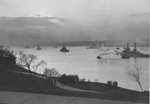
013933q | 1.10k | At sundown, showing our battleship fleet at anchor in the Hudson River during the Naval Review of the Victory Fleet, December 1918.
The Arizona (BB-39) is in the right foreground. | Photo i.d. courtesy of Richard M. Jensen.
National Archives Identifier:45513401
Local Identifier: 165-WW-337D-48.
Photo courtesy of catalog.archives.gov
|
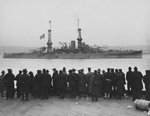 | 541k | "The leader Arizona (BB-39) passing 96th St. Pier in great naval review at N.Y. City, December 1918. | Photo by Paul Thompson.
National Archives Identifier: 45512471
Local Identifier: # 165-WW-334A-4A
Photo courtesy of catalog.archives.gov
|
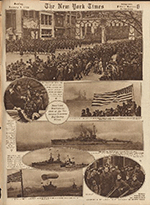 | 697k | New York Welcomes Men of the Victorious Overseas Battleship Fleet
BLUEJACKETS FROM THE ARKANSAS (BB-33) SWINGING DOWN FIFTH AVENUE, BOY SCOUTS MEANWHILE SINGING ROLLICKING MARCHING SONGS
SECRETARY OF WAR, NEWTON D BAKER, in the Official Reviewing Stand, Receiving a Cup of Hot Coffee from Mrs. Julian M. Gerard, Secretary Daniels of the Navy, Served First
THE HUGE FLORIDA (BB-30) CROWDING AND SHOULDERING HER WAY INTO NEW YORK HARBOR WATERS IN THE WINTER'S FIRST SNOW STORM
THE ARIZONA (BB-39) LEADING THE RETURNING HOME OVERSEAS FLEET INTO NEW YORK HARBOR THROUGH A SNOW STORM AND HALF-A-GALE
THE NEW YORK (BB-34), REAR ADMIRAL HUGH RODMAN'S FLAGSHIP of the Overseas Fleet,...on Entering New York Harbor, Firing a Salute in Honor of the Secretary of War.
A "BLIMP" OF THE ATLANTIC FLEET SWINGING AT ANCHOR ABOVE THE MOTHER SHIP IN THE HUDSON
SEVERELY WOUNDED AMERICAN VETERANS MADE COMFORTABLE ON FIFTH AVENUE TO REVIEW THE PARADE OF THE RETURNING SAILORS
| Text & photo courtesy of Times Photo Service N.Y. Times, 5 January 1919, Page 6, courtesy of memory.loc.gov. |

013924a |
4.73k |
Arizona (BB-39) leading the 6th Battle Squadron, just returned from European waters. | Photo by Enrique Muller, Jr.
National Archives Identifier: 55242084
Local Identifier 111-SC-41479.
Photo courtesy of catalog.archives.gov |
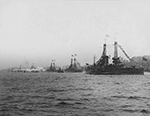 | 739k | OVERSEAS FLEET IN HUDSON RIVER
Right to left: Nevada (BB-36), Oklahoma (BB-37), Arizona (BB-39), New Mexico (BB-40) & Mississippi (BB-41). | Photographer: Paul Thompson
National Archives Identifier: 45513390
Local Identifier: 165-WW-337D-43.
Photo courtesy of catalog.archives.gov
|
 | 246k | Arizona (BB-39) at U.S. Naval Yard, Norfolk, Va., Dry dock No. 4 wall north east side from west, Geo. Leary Construction Company, 30 January 1919. | Photo i.d. courtesy of Richard Jensen.
National Archives Identifier: 52558335
Local Identifier: 181-V-2057
Photo courtesy of catalog.archives.gov |

013989 | 2.03k | Arizona (BB-39), Sao Paulo, (Brazilian battleship) & North Dakota (BB-29) in an unidentified port.
Photo dates from June 1918, when Brazil sent Sao Paulo to the United States for a full refit that was not completed until 7 January 1920.
The date is probably early 1919 & the port is Norfolk, VA. | Photo UA 420.02, courtesy of history.navy.mil
Partial text via en.wikipedia.org
|
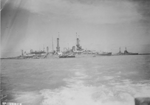
013912a | 618k | The fleet in Guantanamo Bay on 24 February 1919.
The Pennsylvania (BB-38) is the ship in the foreground, based on the pilothouse configuration. Nevada (BB-36) is beyond her forward, based on the mast platforms, and Arizona (BB-39) is beyond her aft based on mainmast location.
They were on or returning their way to Puerto Rico during the 1918 San Fermín earthquake.
| Photo i.d. & text courtesy of Photo by Sergt. McGarricle.
National Archives Identifier: 55238971
Local Identifier 111-SC-39928
Photo courtesy of catalog.archives.gov |
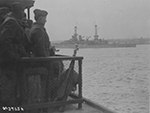 | 237k | Battleships Louisiana (BB-19) & New Hampshire (BB-25) dock at Hoboken, New Jersey. From the top deck of the ferry to Long Island City, the returning soldiers watch a Pennsylvania (BB-38 / 39) class battleship on its way down the harbor, 14 February, 1919. | Photographer: 2nd Lieutenant George H. Lyon.
National Archives Identifier: 26433759
Local Identifier: 165-WW-139A-65
Photo courtesy of catalog.archives.gov |
 | 548k | Three photo PDF of the Winners of Battenburg (sic) Cup, April 6, 1919" (the second of two such-captioned RPPCs being listed today) ~ the Arizona's (BB-39) won this whaleboat race trophy two years in a row (1918 / 1919). | Photos courtesy of Tommy Trampp.
|
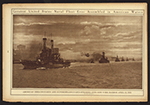 | 1.78k | "American dreadnoughts & superdreadnoughts steaming into New York harbor 14 April 1919."
The Texas (BB-35) leads the procession with a airplane on her turret catapult. Note the escorting biplane.
The "escorting" aircraft is either a Curtiss HS-1 or HS-2 (note the single engine) can't tell which from the photo. The aircraft on a fly-off platform atop the No. 2 turret of the Texas is 1 of 6 Sopwith Camels purchased from Britain at the end of the war.
The platforms were a British concept designed to provide the fleet with an aircraft capable of reaching the high flying Zeppelins which the German Navy occasionally used as scouts. The Texas was the only US Battleship to be fitted with turret fly-off platforms while in Europe and was the test bed for this program in the US Navy. Not visible in this view is a stripped down (No fabric and no wings) Sopwith 1-1/2 Strutter lashed atop the No. 3 Turret. The platforms were eventually mounted on all 14" gun BB's through the New Mexico (BB-40 / 42) class (with mixed reviews from their commanders) and carried either a Hanriot HD-1 or a Nieuport' 28. Though equipped inflatable floats for water landings, this tended to do a lot of damage not the least of which was dowsing a hot engine in cold salt water. By 1920 a successful compressed air catapult was developed and were being mounted on the aft deck of all 4 turreted battleships and fly-off platforms were removed. The Texas and New York (BB-34), because of their 5 Turrets, lacked the deck space for the catapult and had to make do with a float plane (Vought VE-7) sitting on the aft deck which would be launched by lowering it over the side for a surface take-off.
If you look carefully at the photo you see the VE-7 on the deck and the A-frame hoist used for handling it. | Photo by Paul Thompson.
Text courtesy of N.Y. Times, page 481, from The War of the Nations (New York), 31 December 1919, courtesy of memory.loc.gov.
Text i.d. courtesy of Chris Hoehn. |
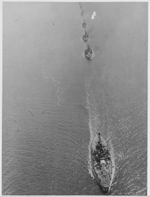
013939n | 2.45k | Leading the battle fleet during maneuvers on 13 April 1919. | USN photo # NH 57646 courtesy of history.navy.mil. |
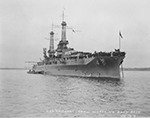 | 407k | Crew of the Arizona (BB-39) witnessing a boat race. | National Archives Identifier: 45512465
Local Identifier: 165-WW-334A-2.
Photo courtesy of catalog.archives.gov
|

013981 | 705k | The ship is Arizona (BB-39) based on the height of the rangefinder above the conning tower. Arizona's pilot house was entirely above the conning tower top, pushing her rangefinder higher up, closer to the level of the lookout position wrapped around the forward cagemast. The date is somewhere between 1919 (when the lookout positions were added to the masts) and her 1929 start for reconstruction. Therefore, this is probably not a combat shot (other than a training exercise). The smoke plumes do not appear to be shell or bomb splashes, but could be smoke from some of the coal burners - note the "slant" of the plumes as the wind pushes them. A shell or bomb splash would more likely rise nearly vertically and then drift with the wind as it started to collapse. The large plume, second from the right, appears to have a ship just to the left of its base. | Text & photo i.d. via Richard M. Jensen.
Photo courtesy of Darryl L. Baker. |
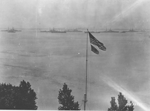
013834n | 1.10k | Photo caption reads Hampton Roads, showing U.S. battleships at anchor. Taken from General Hospital #43, Hampton, Va, between 20 May through 7 June 1919.
Left to right we have Pennsylvania (BB-38), New York (BB-34), an unidentified Florida class BB obscured by the collier, Arizona (BB-39), and then North Dakota (BB-29). The shot was taken in a very narrow window between the time that the Pennsylvania and Arizona were fitted with their pilot houses and the time that the lookout stations were added to the cage masts. |
Photo & text i.d. via Richard M. Jensen
Photo by Sgt. P.R. Newberg
National Archives Identifier: 86719165.
Local Identifier: 111-SC-56991
Photo courtesy of catalog.archives.gov |
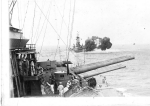 |
144k | Arizona (BB-39) firing a salvo of 14" guns. Picture from the bridge of the Mississippi (BB-41). Photo circa late ten's - early 20's. | Photo from collection of crewmember Reynold Oberg, submitted courtesy of his grandaughter Sherry Witt. |
 | 229k | 1 January 1920 photo of the Arizona (BB-39) at anchor in Guantanamo Bay, Cuba. The forward sections of both flying-off platforms have been removed, but their lower clamp supports are visible on the gun barrels. Wet guns are gone and ports plated over and octagonal searchlight platforms are higher up on the masts. | USN photo contributed by Mike Green, courtesy of Leeward Publications. |
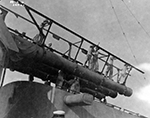 | 324k | Shown: Assembly of take off platform onboard the battleship Arizona (BB-39), January 1920. | USN photo # 80-G-1038256 courtesy of Tracy White @ Researcher @ Large. |
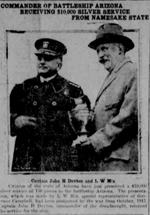 | NR | COMMANDER OF BATTLESHIP ARIZONA (BB-39) RECEIVING $10,000 SILVER SERVICE FROM NAMESAKE STATE
Captain John H. Dayton and I.W. Mix. | Image and text provided by Oklahoma Historical Society.
Photo from The Guthrie Daily Leader. (Guthrie, Okla.) 1893-1996, 07 January 1920, HOME, Image 1, via chroniclingamerica.loc.gov.
|
 |
1.46k |
A painting by the artist Wayne Scarpaci entitled 'Into the Storm'.
This is my latest effort on the Battleship Nevada Centennial Project. It shows the Nevada (BB-36) in 1920 with sister ship Oklahoma (BB-37) and near sister Arizona (BB-39). Notice the 'Flying Off' platform atop turret 2. The platform folded out over the gun barrels and a wheeled aircraft would take off unassisted. The ship was unable to recover the plane so it would have to fly to a shore base to land. Starting in the mid-1920's compressed air launch catapults for floatplanes were added to all US battleships on their fantails. A light derrick type crane was added to the very stern to hoist the aircraft back aboard. In the the mid 1930's the compressed air catapult was replaced with a powder launch type (Which used a 5" powder charge). And a second catapult was added to the top of turret 3 and heavier crane added astern to handle the ever increasing weight of the aircraft carried. Early in WWII the catapult atop turret 3 was removed in all US battleships. In 1947 the USN cancelled the shipboard float plane program and removed the catapults from all ships. All three of the ships in this painting were sunk at Pearl Harbor and only Nevada was returned to service.
| Photo and text courtesy of artbywayne.com
|
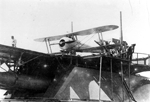 | 579k | A French built Nieuport aircraft is pictured on a wooden deck constructed atop a turret on the Arizona (BB-39) circa 1920.
| Photo courtesy of US Navy and Marine Corps Museum/Naval Aviation Museum, Photo No. 1996.253.7217.003 via Mike Green. |
 | 560k | A French built Nieuport aircraft is pictured on a wooden deck constructed atop a turret.
Note the Arizona's (BB-39) bell behind the plane. | LOC Photo courtesy of David Valenzuela's Battleship Arizona Book Pics via flickr.com.
|
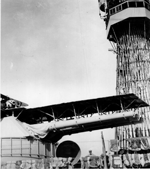 | 421k | Nieuport 28C-1 fighter mounted on the gun platform of the battleship Arizona (BB-39), circa 1920. | USN photo courtesy of Robert Hurst. |
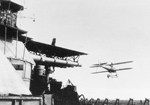 | 489k | A French built Nieuport aircraft is pictured taking off from Arizona's (BB-39) wooden deck constructed atop a turret. | LOC Photo courtesy of David Valenzuela's Battleship Arizona Book Pics via flickr.com.
|
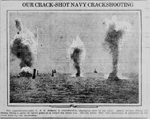
013903 | 806k | A magnificent salvo.
The Arizona (BB-39), while steaming at top speed, lets go all twelve of her 14-inch guns at once in a terrific broadside during winter target practice in Cuban waters.
The huge shells of the Arizona's 14-inch guns dropping all around the target. The Arizona is the only super-dreadnought of the navy to carry a white "E" on all her big gun turrets for excellency in marksmanship. The mighty floating fortress also wears a white "E" on nine of the twenty-two 5-inch rifles of her secondary battery and carries the same coveted emblem on her fire control tower.
| Images provided by: Library of Congress, Washington, DC. & Arizona State Library, Archives and Public Records; Phoenix, AZ.
PDF courtesy of New-York Tribune. (New York [N.Y.])1866-1924, 14 March 1920, Image 53, & Arizona Republican. [volume] (Phoenix, Ariz.) 1890-1930, 19 March 1920, Image 13, via chroniclingamerica.loc.gov. |
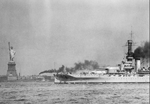
013964b |
422k | Arizona (BB-39) passes by the Statue of Liberty during the roaring 20's. | Photo courtesy of pinterest.com.
|
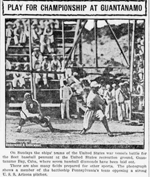
013930a | NR | PLAY FOR CHAMPIONSHIP AT GUANTANAMO
On Sundays the ships teams of the United States war vessels battle for the fleet baseball pennant at the United States recreation ground, Guantanamo Bay, Cuba, where seven baseball diamonds have been laid out. There are also many fields prepared for other sports. The photograph shows a member of the battleship Pennsylvania's (BB-38) team opposing a strong Arizona (BB-39) pitcher. | Image and text provided by University of Vermont.
Photo from Essex County Herald. [volume] (Guildhall, Vt.) 1873-1964, 26 March 1920, Image 2, via chroniclingamerica.loc.gov. |
 |
237k | Foreground is definitely Tennessee (BB-43). In the middle is Idaho (BB-42) (darker camouflage note also the fantail catapult) and upper right is Arizona (BB-39), less certain but based on main mast platforms verses the New Mexico (BB-40). Middle background is New York (BB-34) (navigation bridge not over hanging conning tower). The far left background is the Texas (BB-35) (blunt bow, 2 funnels).
The aircraft is a Naval Aircraft Factory / Curtiss / Canadian Aeroplane Ltd F-5L.
The date of Mr. Kreisman's photo has to be 1920-1921. By 1922 all 14" and 16" gunned BB's (except New York and Texas as the 5th turret did not leave enough deck space) had been fitted with a compressed air catapult on the stern. The presence of a stern A/C catapult on only one of the three 1916 program BB's suggest this early in the introduction of this equipment but late enough for the turret top fly-off platforms to have been removed from all ships present. In 1919 the Battle Fleet shifted its base to San Pedro in California where it remained based until shifted to Pearl Harbor. The Texas and New York were assigned to that fleet until they returned east for modernization in 1925. This would suggest that the photo was taken some where in the Pacific. The rich flora onshore suggest a tropical climate and the enclosed by would lead me to guess Panama or Gitmo. If the 1920 or 1921 Fleet problem was conducted in Atlantic waters could explain an Atlantic based aircraft with a Pacific based Fleet.
|
Photo courtesy of Lance Kreisman via Fabio Pena.
Photo & text i.d. courtesy of Chris Hoehn, Alan Moore & Richard Jensen.
Aircraft i.d. courtesy of Alan Moore via Larkins, William T. US Navy Aircraft 1921-1941/US Marine Corps Aircraft 1914-1959. [The image came from the USMC aircraft section, pg(9).] Atglen, PA: Schiffer Publishing, 1995. (originally published as US Marine Corps Aircraft 1914-1959, copyright 1959, and US Navy Aircraft 1921-1941, copyright 1961). |
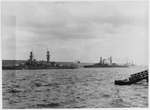
013927b | 6.44k | Lying off Riverside Drive, New York City, on 4 May 1920. Looking up river, the ships are: Pennsylvania (BB-38), Arizona (BB-39), Nevada (BB-36), and Oklahoma (BB-37). They are flying church pennants above the colors on the flagstaffs. | Photo NH 63340, courtesy of history.navy.mil
|
 |
176k | The Pennsylvania (BB-38) or Arizona (BB-39) is in the background in this 1920 photo.
The Bureau of Construction and Repair letter of 21 May 1920, requesting information on any special painting and/or markings being used in the field showed most units to be painting their aircraft as specified. However, the reports show variations had been adopted locally by nearly every installation. Aircraft of the Atlantic Fleet Air Detachment were identified by a system of black and white stripes or squares on the hull of each flying boat. These had been developed to aid in joining up for squadron formations, allowing each aircraft to be recognized almost as far as it could be seen. This, of course, was not possible with the small serial numbers. The actual design was considered of no importance so long as the various designs were distinctive.
One aircraft was left with the original painting to which the last two digits of the serial number were painted on the sides of the hull. These numbers were repeated on the bottom of the hull, with the tops forward, in numerals 4 feet (121.92 cm) high.
While this system was satisfactory for the 6 flying boats of the detachment, its use in a larger force was questioned.
So-called ‘Dazzle' finishes were appearing on USN seaplanes in 1917. The Burgess-Dunne Company initiated the finish, which was characterized by dark and light irregular patterns. NAF F5Ls were later seen and photographed in a dark and light striped pattern. F5Ls were also photographed in a checkerboard pattern of dark and light shades. A February 1917 C&R Report, File 13-Z-11 mentions Vermillion (approximately FS11140) and Off-White (approx. FS37778) as being used in the ‘Dazzle' scheme. This color mention was part of a Naval Air Station (NAS) Pensacola, Florida Board of Painting Seaplanes Letter, same date. | Photo & text i.d. courtesy of Chris Hoehn & Alan Moore.
Aircraft i.d. courtesy of Alan Moore via Elliott, John M. The Official Monogram US Navy & Marine Corps Aircraft Color Guide, Vol 1: 1911-1939. Boylston, MA: Monogram Aviation Publications, 1987. p22. & Doll, Thomas E. US Navy Aircraft Camouflage & Markings 1940-1945. Carrollton, TX: Squadron/Signal Publications, 2003. p3. |
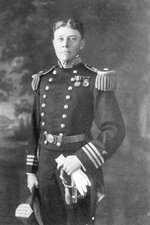 | 152k | Capt. William Woodward Phelps was the commanding officer of the battleship Arizona (BB-39) from 26 June 1920 to 11 June 1921. | Photo courtesy of the USNA Alumni Association via Bill Gonyo. |

013921s | NR | The above photograph shows a scrimmage between the bluejackets of the battleship Arizona (BB-39) and the varsity of Stevens College during a stiff game played between these two teams recently. Every college in and around New York was challenged by the sailors. As a result many of these college teams have a great deal of respect for the bluejacket elevens.
Whenever one of these battleship teams goes ashore for a game everyman entitled to shore liberty goes along with it to root for the navy colors. Spectators are always treated to a brand of rooting seldom witnessed in any field of sport, and learn many new unique expressions of the sea.
| Image and text provided by Louisiana State University; Baton Rouge, LA.
PDF courtesy of The Star-Progress. (Opelousas, La.) 1917-1921, 05 January 1921, Image 7, via chroniclingamerica.loc.gov. |
 | 49k | "Combined Atlantic and Pacific Fleets in Panama Bay, January 21st 1921".
Right section (of three) of a panoramic photograph taken by M.C. Mayberry, of Mayberry and Smith, Shreveport, Louisiana.
Among the ships present in this image are (from left to right): Sicard (DD-346), Hatfield (DD-231), North Dakota (BB-29), Delaware (BB-28), Brazos (AO-4), Prometheus (AR-3), Utah (BB-31), Oklahoma (BB-37), Bridge (AF-1), Nevada (BB-36), Schenck (DD-159), Arizona (BB-39), Black Hawk (AD-9), Dickerson (DD-157), Dahlgren (DD-187), Herbert (DD-160), Columbia (CA-16), Cleveland (PG-33), Tacoma (PG-32), Semmes (DD-189) and one other destroyer.
| Photo # NH 86082-C, courtesy of Naval Historical Center, D.H. Criswell Collection. |
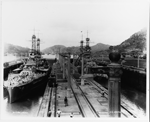
013946a | 4.93k | Oklahoma (BB-37) and Arizona (BB-39) Caption: In the Pedro Miguel locks, Panama Canal in January 1921. Ship in distance is Nevada (BB-36).
| Photo NH 89443, courtesy of history.navy.mil
|
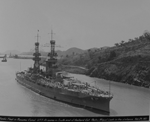
013990 |
914k |
Atlantic Fleet in Panama Canal. Arizona(BB-39) in South end of Gaillard Cut Pedro Miguel Lock in the distance 23 February 1921 |
Local Identifier: 185-G-971
National Archives Identifier: 100996484
Local Identifier: 165-WW-334A-53.
Photo courtesy of catalog.archives.gov |
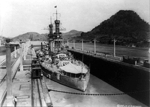 | 600k | Stern view of the Arizona (BB-39) traversing the Panama Canal in 1921. |
Library of Congress photo # LC-USZ62-98338 courtesy of Mike Green. |
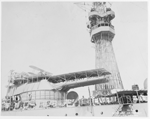
013911a | 25.6k |
View of number 3 turret, with a Nieuport 28 airplane on the flying-off platform, at Guantanamo Bay, Cuba, circa spring 1921. Note: airing hammocks and mainmast details. |
Photo # NH 43918, courtesy of history.navy.mil |
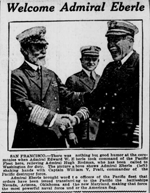
013932b | NR | Welcome Admiral Eberle
SAN FRANCISCO: There was nothing but good humor at the ceremonies when Admiral Edward W. Eberle took command of the Pacific Fleet here, relieving Admiral Hugh Rodman, who has been called to Washington for duty. The picture above shows Admiral Eberle (left) shaking hands with Captain William V. Pratt, commander of the Pacific destroyer force.
Admiral Eberle brought word to officers of the Pacific fleet that orders have been issued transferring to the Pacific the battleships Nevada (BB-36), Arizona (BB-39), Oklahoma (BB-37) and the new Maryland (BB-46), making that force the most powerful naval force under the American flag.
| Image and text provided by Rutgers University Libraries.
Photo & text by Perth Amboy Evening News.[volume] (Perth Amboy, N.J.) 1903-1959, 21 July 1921, LAST EDITION, Image 4, via chroniclingamerica.loc.gov. |
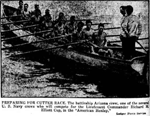 | NR | PREPARING FOR CUTTER RACE. The battleship Arizona (BB-39) crew, one of the several U. S. Navy crews who will compete for the Lieutenant Commander Richard M. Elliott Cup, in the American Henley | Image and text provided by Penn State University Libraries; University Park, PA.
Photo courtesy of Evening Public Ledger. (Philadelphia [Pa.]) 1914-1942, 20 May 1921, Night Extra Closing Stock Prices, Image 36, via chroniclingamerica.loc.gov.
|
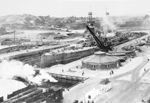 | 871k | Arizona (BB-39) probably at Puget Sound Navy Yard in 1921. | Photo i.d. courtesy of Chuck Haberlein.
LOC Photo courtesy of David Valenzuela's Battleship Arizona Book Pics via flickr.com.
|
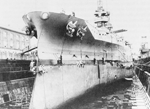 | 433k | Scraping' & painting the hull while in dry dock. | LOC Photo courtesy of David Valenzuela's Battleship Arizona Book Pics. via flickr.com.
|
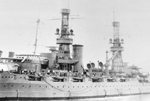 | 288k | Portside view showing business section of the Arizona (BB-39). | LOC Photo courtesy of David Valenzuela's Battleship Arizona Book Pics via flickr.com.
|
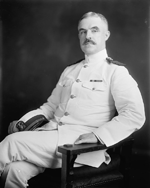 | 103k | Captain George Ralph Marvell was the Commanding Officer of the battleship Arizona (BB-39) from 24 December 1921 to 27 July 1922.
| Photo # 18804v courtesy of the Library of Congress via Bill Gonyo. |
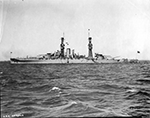 |
1.40k |
Arizona (BB-39) port broadside view, March 1922. |
National Archives Identifier: 6037251
Local Identifier: 19-LC-19-A-18
Photo courtesy of catalog.archives.gov courtesy of Tracy White @ Researcher @ Large. |
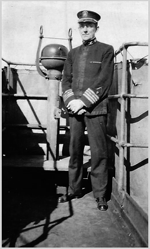 | 182k |
John Russell Young Blakely was born 17 July 1872 in Philadelphia. He was the son of John Blakely, publisher of the Philadelphia Star newspaper, and the nephew of John Russell Young and Congressman James Rankin Young. After graduating Philadelphia's Central High School in 1888, he was appointed to and graduated from the Naval Academy in 1892. After serving in various Navy ships and at many shore stations, he took his first command, Des Moines (CL-17), in 1914. As captain of this ship, and later Seattle (CA-11), Blakely rendered important service in transporting and escorting troops and supplies to Europe during the First World War. For his outstanding contribution he was awarded the Navy Cross. Following the war Blakely served with the Chief of Naval Operations, at the Naval War College, and with the rank of captain he commanded Arizona (BB-39) from 27.07.1922 - 29.11.1923. After a tour as Assistant to the Chief of the Bureau of Navigation in 1925, he was promoted to Rear Admiral and given command of a cruiser division. He also commanded the 15th Naval District and served on the important General Board before poor health forced him to retire 1 June 1932. Rear Admiral Blakely died on 28 March 1942 in Denver, Colo.
J.R.Y. Blakely (DE-140) (1943-1946) was the first ship to be named in his honor. |
Photo courtesy of Alan Wagner via Ron Reeves (of blessed memory).
Image and text provided by Library of Congress, Washington, DC.
Photo from the Evening Star. [volume] (Washington, D.C.) 1854-1972, 28 March 1942, Image 1, courtesy of chroniclingamerica.loc.gov.
|
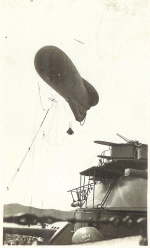 | 176k | Photo-postcard of the Arizona (BB-39), dated 30 November 1922, probably at San Diego CA. Photo probably taken autumn 1922 on goodwill trip to Lima Peru. Photographer stood about 6 feet above the main deck on the starboard side of the mainmast, facing aft. Top center, kite balloon with two observers in basket tethered somewhere off the left side. Right, "C" turret trained aft showing protruding rangefinders, superimposed 3-inch anti-aircraft gun, and airplane platform braced on gun tubes, all shortly removed. Lower left, "D" turret trained out about 90 degrees to starboard. Main deck not visible.
| USN photo by Fred Whitmeyer.
Photo and text submitted by Bruce D. Liddell. |
 | 766k | View of the cage mast with Arizona's (BB-39) Marines. | LOC Photo courtesy of David Valenzuela's Battleship Arizona Book Pics via flickr.com.
|
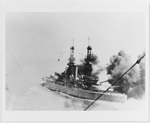
013940a | 1.61k | Firing 14" gun broadside, during battle practice, 1920s. | Photo NH 78118, courtesy of history.navy.mil
|
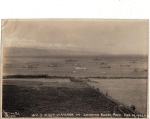 | 104k | U.S. Pacific Fleet at anchor in Lahaina Roads, Maui, Hawaii, 14 February 1923. | Courtesy of Edgar Combs. |
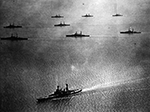 | 1.60k | U.S. Navy Battle fleet steaming into Panama Bay to join scouting fleet for combined fleet maneuvers, probably 1923.
The irony of this photo is that the ship with the least certain ID is the one closest to the camera! The probability is that she is the California (BB-44) based on the fact that the 3 Colorado class (BB-45 / 48) operated for such a short time without catapults and the ship in the photo has a bare quarterdeck). The photo is not clear enough to show twin or triple turrets. However, the ships in the background show enough unique characteristics to give more certainty about an ID. The nearest column are, left to right, Mississippi (BB-41) (uneven lookout station heights on the cagemasts), Tennessee (BB-43), (unique searchlight towers on after stack), and Idaho (BB-42) (lower bridge than New Mexico (BB-40)). The two ships in the second column are New York (BB-34) (bridge does not extend out far enough to be Texas (BB-35)) and Nevada (BB-36) (no enclosed lookout stations on the cagemasts and she has a catapult on her quarterdeck). The farthest column has (again left to right) Arizona (BB-39) (lower bridge), Pennsylvania (BB-38) (higher bridge) and New Mexico (again, the higher bridge). It is interesting that the only apparent catapult is the one on the Nevada. This would place the photo in the 1922-24 time frame. | Ernest La Rue Collection, Gift of the U.S. Army. Courtesy of the Library of Congress. USN photo # Lot-11952-VI-37, courtesy of the National Museum of the U.S. Navy, courtesy of flickr.com.
Photo & text i.d. courtesy of Richard M. Jensen.
|
 | 819k | Panoramic photo of the U.S. fleet in Panama Bay (Pacific entrance to the Panama Canal) on 1 March 1923. 70 vessels are viewed; the Battle Fleet consists of all U.S. battleships from the Delaware (BB-28) through the Idaho (BB-42). | Source: Library of Congress Prints and Photographs Division, courtesy of Tom Kermen. Copyright R.G. Lewis, Y Photo Shop, Balboa, C.Z." |
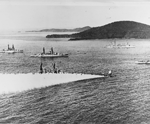
014508 |
1.69k | A naval scouting plane lays a protective smokescreen during maneuvers in the Caribbean Sea, 21 March 1924. Left to right: New York (BB-34/35) class battleship; Pennsylvania (BB-38/39) class battleship; Tennessee (BB-43/44) class battleship (behind smoke); Omaha (CL-4/13) class cruiser; Tennessee or Colorado (BB-45/48) class battleship (stern only visible). | Photo NH-69203 courtesy of history.navy.mil
|
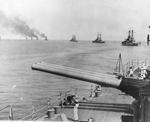 |
2.35k |
The Pennsylvania (BB-38) follows other battleships during maneuvers. The first three ships in the background are Nevada (BB-36), Oklahoma (BB-37), and Arizona (BB-39) in that order. However, the photo pre-dates the 1925 Australia/ New Zealand tour since Oklahoma lacks the enlarged lookout stations on the cagemasts. |
Photo i.d. & text courtesy of Richard Jensen.
Photo courtesy of Pieter Bakels. |
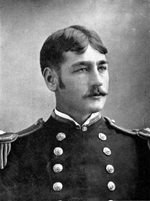 | 152k | Captain Percy Napier Olmstead commanded the battleship Arizona (BB-39) from 29 November 1923 to 27 June 1925. | Photo courtesy of the Baker County Library – Baker City, Oregon via Bill Gonyo. |
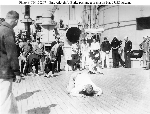 | 85k | Ensign Arleigh A. Burke, USN, pushing a peanut by blowing on it, during a shipboard competition on board Arizona (BB-39), circa 1923-1925.
| Naval History and Heritage Command # NH 100267, now in the collections of the National Archives. Collection of Admiral Arleigh A. Burke, 1975.
|
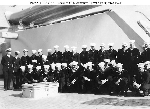 | 76k | Crew of Turret Four (4th Division), Arizona (BB-39), commanded by Ensign Arleigh A. Burke, circa 1924. Ensign Burke is standing at the far left.
| Naval History and Heritage Command # NH 83967, now in the collections of the National Archives. Collection of Admiral Arleigh A. Burke, 1975.
|

013947f | 674k | Arizona (BB-39) with units of the scouting fleet, at Guantanamo Bay, Cuba, in 1924. Mahan (DD-102) is at left.
| Photo NH 76125, courtesy of history.navy.mil |
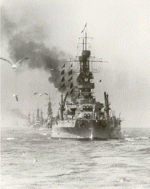 | 60k | Arizona (BB-39) steaming in line ahead with at least four other battleships astern, in the 1920s.
Arizona alternately served as flagship for Battleship Divisions 2, 9 or 4. Based at San Pedro, during this period, Arizona operated with the fleet in the operating areas off the coast of southern California or in the Caribbean during fleet concentrations there. She participated in a succession of fleet problems (the annual maneuvers of the fleet that served as the culmination of the training year), ranging from the Caribbean to the waters off the west coast of central America and the Canal Zone; from the West Indies to the waters between Hawaii and the west coast.
| USN / USNI photo.
Text courtesy of DANFS.
|
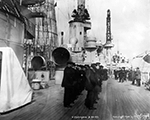 |
1.30k |
Arizona (BB-39), crew in formation. Photographed by Irving Underhill, 1924. | USN photo # Lot 12449-2 photographed thru Mylar sleeve, from the National Museum of the U.S. Navy via flickr.com. |
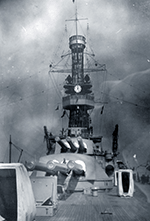 |
854k |
Arizona (BB-39), showing 14-inch guns and cage mast. Photographed by Irving Underhill, 1924. | USN photo # Lot 12449-3 photographed thru Mylar sleeve, from the National Museum of the U.S. Navy via flickr.com. |
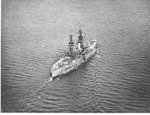 | 3.71k | February 1925 photo of the Arizona (BB-39) before the placement of stern catapults. | Text contributed by Mike Green, courtesy of Leeward Publications.
USN photo #80G-461443 courtesy of Paul Silverstone. |
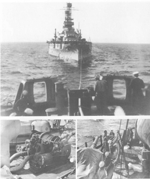 | 826k | Fueling tests conducted between Kanawha (AO-1) and Arizona (BB-39) in the mid-1920s.(Top) Kanawha playing out towing line. (Lower left) The steam-powered tension engine was a special device installed on Kanawha so that the fuel lines would not drag in the water while fueling astern. (Lower right) The crew sets the steel tension line. | USN photo from Gray Steel and Black Oil: Fast Tankers and Replenishment at Sea in the U.S. Navy, 1912-1995, via Robert Hurst.
|
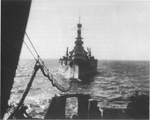 | 586k | Arizona (BB-39) is in tow while fuel is transferred from the Kanawha (AO-1) via the astern method. Note how the steel tension wire keeps the fuel hose from dipping into the sea. | USN photo from Gray Steel and Black Oil: Fast Tankers and Replenishment at Sea in the U.S. Navy, 1912-1995, via Robert Hurst.
|
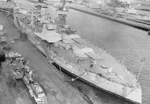 | 1.13k | A catapult-less Arizona (BB-39).
According to Stillwell's book the base was installed by mid 1925. The stern cat itself was installed in a refit from mid June to mid September (Stillwell, p87). A photo on the following page that shows the cat was dated March of '26. The turret cat was added between Arizona' post-modernization recommissioning (July '31) and the spring of 1932.
The vessel in front is probably a Cuyama class oiler, of which there is a choice of three: Cuyama (AO-3), Brazos (AO-4) or Neches (AO-5) ... all presuming that there really are only six letters in the ship's otherwise unreadable name. Taking a wild guess, I'd bet about a Dime that she's Brazos, since that is the only one of the class that wasn't carrying deck guns during the 1920s (otherwise, there ought to be a 5" gun on each side aft). However, I'm not even close to certain about that.
| Text i.d. courtesy of Richard Jensen & Chuck Haberlein.
LOC Photo courtesy of David Valenzuela's Battleship Arizona Book Pics via flickr.com.
|
 | 77k | Crewmen of the Arizona (BB-39) pose under the ships rudder while in drydock in 1925. | USN photo contributed by Robert M. Cieri. |
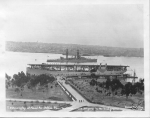 | 173k | Arizona (BB-39) and Langley (CV-1) at Naval Air Station San Diego, CA. circa late 1920's. | Photo courtesy of USN photo. / Joseph M. Radigan (of blessed memory).
Text courtesy of Tracy White @ Researcher @ Large. |
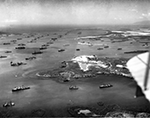 |
2.60k |
Ships of the U.S. Fleet pictured at anchor at Guantanamo Bay, Cuba, during winter exercises in 1927.
The "center" row has Mississippi (BB-41) then Langley (CV-1) , Oklahoma (BB-37), Pennsylvania (BB-38) and Arizona (BB-39) in that order. The next row to the left has Idaho (BB-42) then New Mexico (BB-40), followed by 3 of the Tennessee/Colorado class (hard to pick out distinguishing features in this photo), with Nevada (BB-36) as tail-end-Charlie. Further to the left are another Tennessee/Colorado class BB and a Memphis (formerly Tennessee) class armored cruiser. Two unidentified Omaha class cruisers are in the foreground. There are at least 17 destroyers, identifiable (bottom, right) is Mahan (DD-102), converted to a minelayer and redesignated DM-7, but still wearing her old DD hull number (102) and two submarine tenders in the foreground with about 10 smaller and two large submarines. The peninsula in the right foreground is South Toro Cay, where the drydock is still visible that was begun in 1904, but cancelled two years later.
|
Photo i.d. courtesy of Richard Jensen & wikipedia.org.
Photo courtesy of wikipedia.org via Branden Deschaine & Fabio Pena.
|
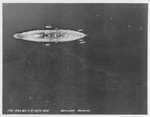
013930 | 3.37k | Off New York City, 2 May 1927.
Imagine this view at Pearl Harbor. | Photo NH-57655, courtesy of history.navy.mil
|
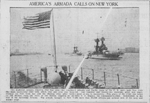
013912 | 806k | AMERICA'S ARMADA CALLS ON NEW YORK
The mightiest armada America ever has seen—the combined Atlantic and Pacific fleets of the U. S. navy—paid New York
the most spectacular visit with which that city ever was honored. One hundred and twenty-two warships, great and small, steamed up New York bay and the Hudson river after weeks spent at sea in maneuvers. This photo of the event was taken on the Hudson from the stern of the Seattle (CA-11), flagship of Admiral C. F. Hughes, the commander-in-chief. Immediately in the rear is the battleship Arizona (BB-39). The armada brought to New York more than 30,000 officers and enlisted men of the navy and marine corps.
| Images provided by Arizona State Library, Archives and Public Records; Phoenix, AZ.
PDF courtesy of Douglas Daily Dispatch. [volume] (Douglas, Ariz.) 1903-1961, 13 May 1927, Image 4, via chroniclingamerica.loc.gov. |
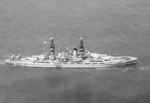 | 421k | June 1927 photo of the Arizona (BB-39) showing the compressed air catapult mounted on the quarter deck. This catapult replaced the two turret-top mounted flying-off platforms. | Text contributed by Mike Green, courtesy of Leeward Publications.
USN photo #80G-460111 courtesy of Paul Silverstone. |
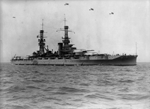 | 1.77k | Arizona's (BB-39) underway with aircraft overhead, 4 June 1927. | Photo # NWDNS-19-N-11007, courtesy of National Archives Record Administration (NARA) via upload.wikimedia.org |
 | 51k | The bridge of the Arizona (BB-39). The photo was taken in the late 1920's, before the bridge was enlarged considerably during the 1929-1931 modernization at the Norfolk Navy yard. | USN photo. |
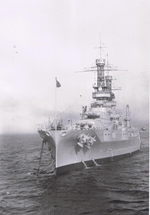 | 1.00k | Arizona (BB-39) at anchor in Port Angeles, Washington, 16 August 1928. | USN photo courtesy of Jim Millholland via Alan Cole.
|
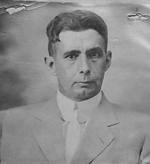 |
64k |
Capt Victor Ashfield Kimberly had a short stint as C.O. of the Arizona (BB-39), 27/06/1928 to 04/09/1928. Apparently he pulled some strings in Washington D.C. to get command of the newer battleship Maryland (BB-46) with her 16 inch guns; he was captain from 06/09/1928 to 16/05/1930. This stunt did not go over with his shipmates on the Arizona and he was not a popular topic in the officers wardroom. This might explain why he never was promoted to Admiral. |
Text courtesy of Bill Gonyo & Wolfgang Hechler.
Photo courtesy of findagrave.com.
|
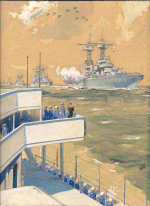 | 122k | Watercolor of a Presidential review during President Hoover's term of office, 1928-32.
Crews line the rails of a Colorado class (BB-45 / 48) battleship as the ships pass in line astern of the reviewing stand with the airship Los Angeles (ZR-3) piercing the clouds accompanied by 9 biplanes. | Courtesy of Michael Schwarz.
|
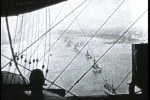 | 56k | View of the U.S. Battlefleet from above, possibly from the airship Los Angeles (ZR-3). | Photo courtesy of periscopefilm.com. |
Modernization / 1929 - 1931
|
 | 289k | Arizona (BB-39) at Norfolk Navy Yard shortly before undergoing modernization. | Photo by CWO4 Cecil Wood USMC, contributed by his son Donald Wood via Gary Priolo. |
 | 1.29k | Superstructure-less Arizona (BB-39) at Norfolk Navy Yard dry dock. This photo was taken very early in the reconstruction process, probably circa July 1929. The cage masts are gone, but the original boat cranes remain. It was not taken during her original outfitting because there is too much superstructure remaining forward. As built she had little but the conning tower and the cage masts. That superstructure was added post WW-I and replaced during the rebuild.
| Text i.d. courtesy of Richard M. Jensen.
Photo by CWO4 Cecil Wood USMC, contributed by his son Donald Wood via Gary Priolo. |
 | 351k | Nevada (BB-36) being modernized at Norfolk Naval Shipyard between 4 May 1929 and January 1930.
The date has to be from this period of time because the Arizona (BB-39) entered Norfolk on 4 May 1929 to prepare for modernization.
Placed in reduced commission on 15 July 1929, Arizona remained in yard hands for the next 20 months; tripod masts, surmounted by three-tiered fire control tops, replaced the old cage masts; 5-inch, 25-caliber antiaircraft guns replaced the 3-inch 50s with which she had been equipped. She also received additional armor to protect her vitals from the fall of shot and blisters to protect her from torpedo or near-miss damage from bombs. In addition, she received new boilers as well as new main and cruising turbines. Ultimately, she was placed in full commission on 1 March 1931.
The Auxiliary to the left of the Arizona is 1 of 8 Patoka class fleet oilers, most likely either Sapelo (AO-11) or Salinas (AO-19).
| USN photograph courtesy of Ric Hedman.
Partial text courtesy of DANFS.
Photo i.d. contributed by Chris Hoehn, Jeff J., Chuck Haberlein & Mike Green. |
 | 89k | Mississippi (BB-41) in the background & Arizona (BB-39) in the foreground being modernized at Norfolk Naval Shipyard between 4 May 1929 and January 1930. | Photo i.d. courtesy of Karl Zingheim.
USN photo from nnsy1.navy.mil contributed by Mike Green. |
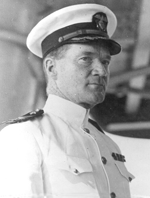 | 466k | Capt. Charles Seymour Freeman was the commanding officer of the Arizona (BB-39) from 20 September 1930 to 20 June 1932. | Photo courtesy of the Library of Congress via Bill Gonyo.
|
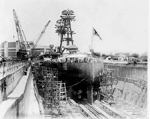 | 434k | Shown in dry dock during her 1929 - 1930 overhaul and modernization at the Norfolk Navy yard. | USN photo. |
 | 252k | Marines show up for a gig of the Arizona (BB-39) at Norfolk Navy Yard. | Photo by CWO4 Cecil Wood USMC, contributed by his son Donald Wood via Gary Priolo. |

013922a | 1.27k | Arizona (BB-39) superstructure removed, during its reconstruction / modernization in 1930 at Norfolk Navy Yard.
| Source: Naval History and Heritage Command, Catalog No. UA 473.001 via Mike Green. |
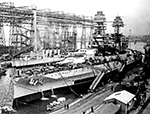 | 1.13k | Arizona (BB-39) undergoing modernization at Norfolk N.Y., 11 December 1930.
The destroyer Cole (DD-155) is in the background. | Photo from The Virginian-Pilot Photograph Collection / SMC Photograph Collection from the Norfolk Public Library (Va.) |
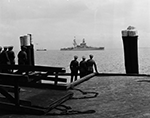 | 1.44k | Arizona (BB-39) at sea off Norfolk, Virginia, 11 December 1930.
Note the Vought 03U-3 in flight. | Photo from The Virginian-Pilot Photograph Collection / SMC Photograph Collection from the Norfolk Public Library (Va.) |
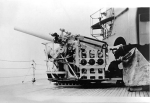 | 30k | A 5-inch anti-aircraft gun. One of the anti-aircraft guns mounted on the superstructure deck during the ship's modernization. | USN photo. |
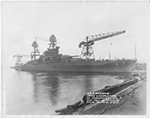 | 1.42k | Arizona (BB-39) at Norfolk Navy Yard on 2 March 1931. | USN photo # 19-LC-19B-2_PR, courtesy of catalog.archives.gov. via Tracy White @ Researcher @ Large. |
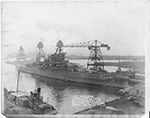 | 1.85k | Arizona (BB-39) at Norfolk Navy Yard on 2 March 1931. Newly modernized, she is complete except for 0.50 caliber machine guns which would later occupy platforms on each mast and a catapult which has not been mounted atop #3 turret. Both boat cranes have been lengthened to serve the catapult. | Text courtesy Pieter Bakels.
USN photo # 19-LC-19B-3_PR, courtesy of catalog.archives.gov. via Tracy White @ Researcher @ Large.
|
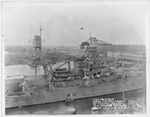 | 1.74k | Arizona (BB-39) at Norfolk Navy Yard on 2 March 1931. | USN photo # 19-LC-19-B-4, courtesy of catalog.archives.gov. via Tracy White @ Researcher @ Large. |
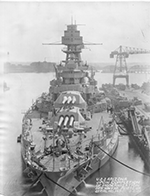 | 1.91k | Arizona (BB-39) after her reconstruction on 2 March 1931 with a new enclosed bridge structure. Note the 5-inch guns that have been added along her deck. | USN photo # 19-LC-19-B-5, courtesy of catalog.archives.gov. via Tracy White @ Researcher @ Large. |
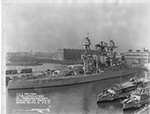 | 2.31k | Stern view of the Arizona (BB-39) on 2 March 1931, newly modernized. During her reconstruction, tripods have replaced the old cage masts. Atop the tripods were mounted three level fire control towers. The bottom level controlled the secondary battery while the upper two levels controlled and spotted for the main battery. The funnel mounted searchlights proved unsatisfactory, so the lights were later moved to platforms on the masts.
Note the stern of the destroyers Blakely (DD-150) & Biddle (DD-151) in the foreground. | Text contributed by Mike Green, courtesy of Leeward Publications.
USN photo #19-LC-19-B-1 courtesy of catalog.archives.gov. via Tracy White @ Researcher @ Large. |
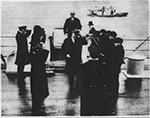 | NR | President Hoover boarding the
battleship Arizona (BB-39) at Old Point Comfort, Va., for his vacation cruise in Southern waters. Secretary Hurly and Secretary Wilbur are following him aboard. | Image and text provided by Library of Congress, Washington, DC.
Photo & text by Evening Star. [volume] (Washington, D.C.) 1854-1972, 29 March 1931, Image 105, & (insert) 19 April 1931, Image 77, courtesy of chroniclingamerica.loc.gov. |
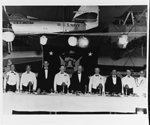
013932 | 1.61k | President Herbert Hoover dines at sea on board Arizona (BB-39). Captain Charles S. Freeman, Commanding Officer of BB-39, is fourth from the left. President and his party were embarked in Arizona for a 10 day tour of Puerto Rico and the Virgin Islands, beginning 19 March 1931. | Photo NH 95970, courtesy of history.navy.mil
|
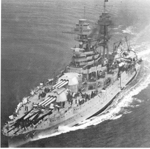 | 1.30k | Underway with President Herbert Hoover on board, March 1931. The Presidential Flag is flying from her mainmast peak. Note the early type quarterdeck aircraft crane. | USN photo courtesy Pieter Bakels. |
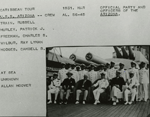 | 993k | Three page PDF showing official party & officers of the Arizona (BB-39) and other scenes aboard ship, March 1931. | Photo courtesy of Herbert Hoover Presidential Library-Museum.
Note; High-resolution scans can be ordered from the site. |
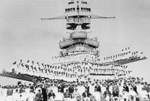 | 917k | The ship's company posed with President Hoover during his cruise on board the Arizona (BB-39), March 1931. The President is seated at the front center. | LOC Photo courtesy of David Valenzuela's Battleship Arizona Book Pics via flickr.com.
Image and text provided by Library of Congress, Washington, DC.
Photo & text by Evening Star. [volume] (Washington, D.C.) 1854-1972, 19 April 1931, Image 77, courtesy of chroniclingamerica.loc.gov. |
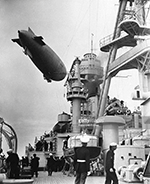 | 904k | Arizona (BB-39) is visited by a dirigible while President Hoover was on board the battleship in the Antilles in 1931. | Photo by Keystone-France\Gamma-Rapho via Getty Images courtesy of gettyimages.com. |
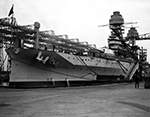 | 1.44k | On 19 March 1931, President Herbert C. Hoover embarked on board the recently modernized battleship, and sailed for Puerto Rico and the Virgin Islands, standing out to sea from Hampton Roads that day. Returning on 29 March, Arizona (BB-39) disembarked the Chief Executive and his party at Hampton Roads, and then proceeded north to Rockland, Maine, to run her post-modernization standardization trials.
Arizona is seen here in port in Norfolk, Virginia, 29 March 1931. | Text courtesy of DANFS.
Photo from The Virginian-Pilot Photograph Collection / SMC Photograph Collection from the Norfolk Public Library (Va.)
Insert image and text provided by Library of Congress, Washington, DC.
Photo & text by Evening Star. ([volume] (Washington, D.C.) 1854-1972, 30 March 1931, Image 2, courtesy of chroniclingamerica.loc.gov.
|

013926a | NR | BOAT PREPARED FOR PRESIDENT HOOVER'S USE
Orginally used on the battleship Arizona (BB-39), was reconditioned for President, cruises on the Potomac. It will accommodate eight passengers and carry a galley, a small cabin, a canopied after deck which has space for six. |
Image and text provided by University of North Texas; Denton, TX.
Photo & text by Brownsville Herald. [volume] (Brownsville, Tex.) 1910-current, 24 May 1931, EARLY SUNDAY EDITION, Image 16, via chroniclingamerica.loc.gov. |

013931u | 312k | Arizona's (BB-39) whaleboat crew won the Battenberg Cup in 1931. | Photo courtesy of Tommy Trampp.
|
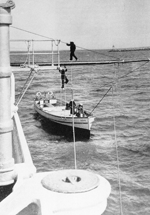 | 432k | Out for a walk on Arizona's (BB-39) boat boom. | LOC courtesy of David Valenzuela's Battleship Arizona Book Pics via flickr.com.
|
 | 368k | The sum of all the parts of a scout plane arrive. | LOC Photo courtesy of David Valenzuela's Battleship Arizona Book Pics via flickr.com.
|
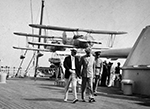 | 879k | President Herbert Hoover and Secretary of War Patrick J. Hurley on quarterdeck. The guns of turret 4 are visible to the right of the photograph. Two of the ship's aircraft are visible behind him, as is the pole crane fitted at the stern during the modernization (it was in place until 1934, when it was upgraded). | Photo # 80-G-416206 from the National Museum of the U.S. Navy via flickr.com.
|
1932 - Pre-Pearl Harbor Attack
|
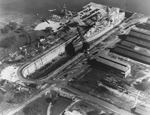 | 1.23k | 1932 aerial photo of the Arizona (BB-39) in Dry Dock No. 1 at Pearl Harbor Navy Base.
Note the # 39 on her turret. | National Archives photo courtesy of Mike Green. |

013932z | 2.65k | My Father, Henry Granville McCabe, was stationed on the Battleship Arizona (BB-39) from 25 Nov. 1930 to 5 Apr. 1934 he was a seamen second class. I have his DD214 and he is pictured in the photograph. The photo is 5 foot long and 10 inches wide it is black & white the sailors are all in dress blues. The photo was taken of the entire crew except for the sailors and marines that were ashore at that time. Photo dated 1932. | Photo courtesy of Henry & Diana McCabe.
|
 | 465k | The destroyer Perry (DD-340) takes fuel from Arizona (BB-39) while participating in the fleet exercises of 1932. | Photo courtesy Kauffman Collection, Naval Historical Center.
Image scanned from Gray Steel and Black Oil: Fast Tankers and Replenishment at Sea in the U.S. Navy, 1912-1995, via Robert Hurst.
|
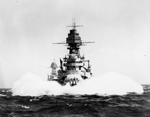 | 776k | Leading Nevada (BB-36), Arizona (BB-39) heads into a sea in May 1932. Note the concentration dial above the rangefinder. | Photo courtesy of the Boston Public Library, Leslie Jones Collection via flickr.com.
|

013919 |
559k |
Arizona (BB-39) in LA harbor, 1934. | Photo courtesy of Inman studio of Long Beach via Paul Ayers.
|
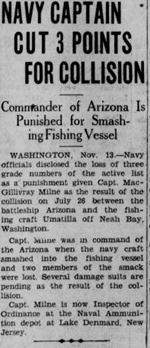
013934a |
2.87k |
NAVY CAPTAIN CUT 3 POINTS FOR COLLISION
Commander of Arizona (BB-39) Is Punished for Smashing Fishing Vessel |
Insert photo courtesy of wikipedia.org
Image and text provided by Alaska State Library Historical Collections.
Photo by The Daily Alaska Empire. [volume] (Juneau, Alaska) 1926-1964, 13 November 1934, Image 1, courtesy of chroniclingamerica.loc.gov. |
 | 19.3k | Seven page PDF Arizona (BB-39) General Plans & Inboard Profile. Original publication date 31 August 1934. Last revision date June 1941. | Text i.d. courtesy of David Perry.
National Archives Identifier: 75840420
Photo courtesy of catalog.archives.gov
|
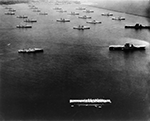 | 2.44k | Ships of the United States Fleet pictured at anchor inside the breakwater at Colon, Canal Zone, 1935.
The carriers are, front to back, Langley (CV-1), Saratoga (CV-3) and Lexington (CV-2). The two battleships beyond Lexington are the New York (BB-34) with Texas (BB-35) behind. The nearest battleship, straight up from the Langley is Pennsylvania (BB-38). The BB immediately beyond and to the left of Pennsylvania (BB-38) is California (BB-44). The remaining battleships include two New Mexico's: Mississippi (BB-41) and Idaho (BB-42), but even this higher rez shot is not clear enough to tell which is which. Also are the rest of the "Big Five" and what is probably one of the Nevada's, but that is not certain. The photo is not clear enough for positive identifications. The cruisers to the left are three Northampton's (CA-26 / 31) and the two Pensacola's (CA-24 & 25) (the pair furthest from the camera) and six Omaha's. | Photo & text i.d. courtesy of Richard M. Jensen.
Photo courtesy of National Naval Aviation Museum (NNAM) photo (# 1996.488.001.006) courtesy of Fabio Pena. |

013315 |
NR |
Seven U. S. Ships Due to Be Scrapped for New Ones
Seven of Uncle Sam's l5 biggest battleships are due to be scrapped and replaced with new ones at cost of $50,000,000 each, if Japan fails to withraw its's denunciation of Washington naval treaty, which expires 31 December 1936, it is indicated in Washington. The treaty forbade construction of new battleships, and limited construction to war vessels of 10,000 tons or less. The ships scheduled to be replaced are shown from left to right & top to bottom: Texas (BB-35) ,Arizona (BB-39) & New York (BB-34).
Oklahoma (BB-37), Arkansas (BB-33), Nevada (BB-36) & Pennsylvania (BB-38).
(Central Press> |
Image and text provided by University of North Carolina at Chapel Hill Library, Chapel Hill, NC.
Photo by Henderson Daily Dispatch. (Henderson, N.C.) 1914-1995, 23 March 1935, Image 6, courtesy of chroniclingamerica.loc.gov. |
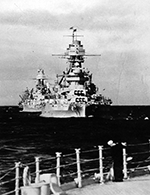 | 486k | Arizona (BB-39) leading Nevada (BB-36) and the Tennessee (BB-43) and a New Mexico class battleship underway.
| USN photo # 80-G-456504 from the National Museum of the U.S. Navy via flickr.com.
|
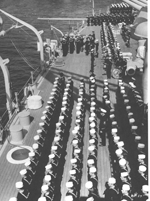 | 534k | 1934 photo of Arizona (BB-39) crew mustered at quarters for the ceremony at which Chesty (James Cagney) is presented the Navy Cross in the movie Here Comes the Navy | Photo inspired by Tommy Trampp via gonebutnotforgotten |
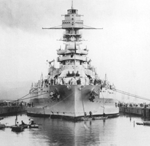 | 486k | Arizona (BB-39) in drydock. | USN photo courtesy of Scott Koen & ussnewyork.com. |
 | 1.60k | Steaming away from the photographer, the Arizona (BB-39) and other ships of the Battle Force, the primary US embodiment of sea power in the mid 1930's. | USN photo courtesy Pieter Bakels. |
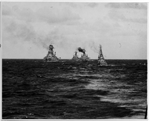
013987 | 900k | The Arizona (BB-39) (L) with (L-R), Tennessee (BB-43), Nevada (BB-36) and Brant (AM-24) en route to Hawaii for fleet maneuvers, 1935. | Photo NH 50258, courtesy of history.navy.mil
|
 | 117k | Arizona (BB-39) inboard & Maryland (BB-46) at Puget Sound sometime circa late 1935, early 1936. The Arizona still has the searchlights on the funnel and the funnel is short. It was extended vertically in early 1936. | USN photo courtesy of Robert M. Cieri.
Text courtesy of Tracy White @ Researcher @ Large.
Photo i.d. courtesy of Mike Green. |
 | 914k | Arizona (BB-39) moored in front of either New York (BB-34) or Texas (BB-35) with the aircraft carriers Lexington (CV-2) & Saratoga (CV-3) during a fleet problem during the 1930's.
The photo might be Culebra, Puerto Rico, or maybe Gonaives, Haiti. | Text i.d. courtesy of Fabio Pena.
LOC Photo courtesy of David Valenzuela's Battleship Arizona Book Pics via flickr.com.
|
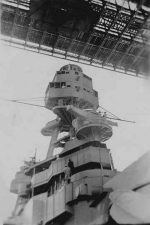 | 539k | This photograph, taken in 1936, shows the forward superstructure. The heavily armored conning tower can be identified by the narrow vision silts. Just above it the ship's bridge is visible. The long "beam" on the platform above the bridge is the range finder, used to aim the ship's main guns. The structures at the top of the tripod mast are stations for controlling the ship's guns. The Arizona (BB-39) is passing under the partially completed Golden Gate Bridge. | USN photo. |
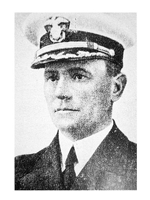 | 147k | Capt. George Andrew Alexander was the commanding officer of the Arizona (BB-39) from the 6th of August 1936 to 12 November 1937. | Photo courtesy of Bill Gonyo.
|

013923a | 2.86k | September 1936 image showing Arizona (BB-39) in her final configuration. Note the walkway around her pilot house, which distinguished her from Pennsylvania (BB-38). Antiaircraft range finders are visible on her range finder platform with 5-inch directors at the emergency cabin level (that is, the level below the navigating bridge) one of them is visible against the after leg of the tripod foremast in a Puget Sound refit completed in March 1939, the funnel searchlight were relocated to the mainmast machine gun platform, their own platform being taken over by a pair of 0.50-calibere machine guns.
The stern of the Nevada (BB-36) is behind her. | USN photo.
Text courtesy of U.S. Battleships: An Illustrated Design History by Norman Friedman. |
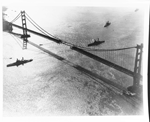
013934 | 6.44k | U.S. Fleet battleships steam under the incomplete Golden Gate Bridge, circa November 1936. Leading ship is Arizona (BB-39), followed by Nevada (BB-36), Maryland (BB-46) and Texas (BB-35). | Photo NH 95911, courtesy of history.navy.mil
|
 | 814k | Curtiss SOC's being placed aboard the Arizona (BB-39). | LOC Photo courtesy of David Valenzuela's Battleship Arizona Book Pics via flickr.com.
|
 | 524k | Curtiss SOC on Arizona's (BB-39) catapult with a Lexington (CV-2/3) class carrier in the background. | LOC Photo courtesy of David Valenzuela's Battleship Arizona Book Pics via flickr.com.
|
 | 145k | One of Arizona's (BB-39) float planes flies past her after being launched from her fantail as another is being made ready on the turret catapult. | USN photo courtesy of David Buell. |
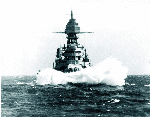 | 195k | 31,000 plus tons of Arizona (BB-39) drive through the sea in the later 1930s. | USN photo from the collection of Andy Small (USNA '83) courtesy of Charles Landrum LCDR, USN (Ret.)USNA '83. Scanned from a sold print at the US Naval Academy Museum marked "Deaccessioned, Remove from USNI Collection." |
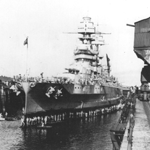 | 445k | Drydock not yet pumped dry, the crew of the Arizona (BB-39) are very likely scraping barnacles.
It would seem that rather than drain the dock and set up scaffolding, all hand have been put over the side into many flat bottom boats and the hull is being scraped by the crew as the water level is slowly lowered in the dock exposing more hull.
| Text i.d. courtesy of Chuck Haberlein & Chris Hoen.
USN photo courtesy of Scott Koen & ussnewyork.com. |
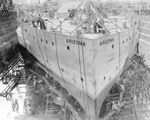 | 815k | Stern view of the Arizona (BB-39) in dry dock; workmen on the propellers with crewmen looking from the deck. | LOC Photo courtesy of David Valenzuela's Battleship Arizona Book Pics via flickr.com.
|
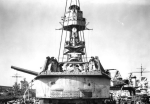 | 79k | The following 2 photographs appeared in this article.
This story was in the Hawaii Navy News Online (Volume 27, Issue 24-June 21, 2002)
"Spring cleaning reveals lost Arizona (BB-39) photos."
BREMERTON, Wash. - You never know what will turn up during spring cleaning - a long-forgotten childhood toy, an old suit you wish you had forgotten or, as was the case at Puget Sound Naval Shipyard, some old photographs that shed new light on a chapter from a part of naval history.
Arizona was at Puget Sound Navy Yard in 1938 for overhaul, but early records are vague. Until now, the historical archives had no information on the specific work done on Arizona during its overhaul here.
The photographs show a turret being lifted from the ship to a temporary foundation. A battleship pier was located directly under the hammerhead crane (built in 1932-33) with a lifting capacity of 250 tons. There are numerous photos in the shipyard photo archives that show the hammerhead crane lifting large armament from the capital ships, but this is the first time that photos have shown the lifting of turrets. This photo shows the bow view above deck portion of the turret and its 3 x 14"/45 guns. Photos are dated 23 May 1938. | USN photo contributed by Mike Green. |
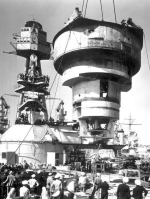 | 108k | The slow process of swinging tons of armored steel out from the ship has begun.
| USN photo contributed by Mike Green.
Text courtesy of ibiblio.org via Bill Gonyo. |
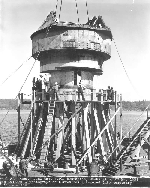 | 117k | Turret #4 being lowered into a temporary foundation for transport. | USN photo & text courtesy of ibiblio.org via Bill Gonyo. |
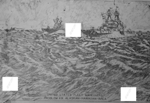 | 1.33k | Drawing of Fleet Problem XIX; it was drawn from the quartermaster deck in 1938 for the original iron man of the Arizona (BB-39)... Marion Brooks (Pat) Tobin . | Photo courtesy of Mike Henley. |
 | 1.36k | Pearl Harbor, 1938: Nautilus (SS-168) with Arizona (BB-39) behind on the right and Pennsylvania (BB-38) on the left. Portland (CL-33) is behind Pennsylvania and the bow of a New Mexico class battleship is at the extreme left. | Photo courtesy of Roger Reynolds.
Photo i.d. courtesy of Richard Jensen. |
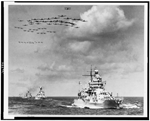 | 463k | Probable front and rear photos here and below showing formations of aircraft flying over U.S. Navy battleships during exercises at sea, 1938 / 1939.
Pictured here is the New Mexico (BB-40) in the van with other battleships of the Pacific Fleet and a carrier air group, led by the Air Group Commander in a Curtiss SBC Helldiver.
The aircraft following are:
A torpedo squadron of eighteen Douglas TBD-1s;
A bombing squadron of eighteen Northrop BT-1s;
A scouting squadron eighteen Curtiss SBCs;
A fighting squadron of eighteen Grumman F2F-1s or F3F-3s from either the Yorktown (CV-5) or F3F-2s from the Enterprise (CV-6), plus possibly nine additional aircraft.
The Yorktown and Enterprise were the only two carriers whose bombing squadrons were equipped with the Northrop BT-1.
The text for the photo reads:
"The Navy uses enormous amounts of rubber. At least seventy-five tons of rubber, enough to makes 17,000 tires, are used in the construction of each of these battleships. Tons more are needed for the naval planes that are making history over the world. Medical and communication requirements--and countless other needs of the Navy--are met."
The lead BB looks like Mississippi (BB-41) followed by Maryland (BB-46) (rangefinder on Turret II). My first impression of the Tennessee class (BB-43 /44) is the Tennessee (BB-43), but that is not a certain ID from this photo alone. Fourth is the Oklahoma (BB-37) (no birdbath). Aside from the DD now in the lead, I see nothing in the head-on shot aerial that positively differs from the ID's of the first 4 BB's in the first photo. Of course, in the aft aerial shot, BB #5 is the California (BB-44), ID'd by the enlarged flag bridge, lending support to BB #3 in the first photo being Tennessee. Everything I see supports these three photos all being part of the same operation with at least the first 5 BB's remaining in the same order. |
Photograph # LC-USE64 - DC-000944 & partial text courtesy of memory.loc.gov.
Battleship i.d. & text courtesy of Richard Jensen.
Aircraft i.d. & text & timeline courtesy of Alan Moore via the following sources: Airplane i.d.: Yorktown Class Carriers (Warship Pictorial No. 9) by Steve Wiper, Tucson, AZ: Classic Warships Publishing, 2000. & That Gallant Ship: U.S.S. Yorktown (CV-5) by Robert Cressman, Missoula, MT: Pictorial Histories Pub Co, 1985. Timeline from Battleship Arizona: An Illustrated History by Paul Stillwell, Annapolis, MD: Naval Institute Press, 1991. |
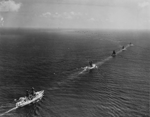 | 1.62k | Probable front and rear photos here and above showing formations of aircraft flying over U.S. Navy battleships during exercises at sea, 1938 / 1939.
New Mexico (BB-40) is leading the BB column while the remaining battleships have dual masthead fire control structures.
The air group formation in the two photos appears to be similar. The composition of 18 TBDs, 18 BT-1s, 18 SBCs, and 27 fighters is easier to distinguish in the front/surface view. I'm assuming, based on total aircraft count alone, that the formation in the rear/aerial view is the same. (The perspective makes it difficult to sort the monoplanes and biplanes into their respective types.) The only difference is that in the front/surface view the formation is lead by a Curtiss SBC Helldiver (likely the Air Group Commander) but in the rear/aerial view that lead Helldiver is not present. I suppose it's possible that the photographer was in that Helldiver's rear seat.
What stands out for me is the presence of nine extra fighters beyond the normal squadron composition of 18, as seen in the other three squadrons in this formation. | Photo i.d courtesy of Chuck Haberlein, Richard Jensen, Aryeh Wetherhorn, & Tracy White @ Researcher @ Large.
Battleship i.d. & text courtesy of Richard Jensen.
Aircraft i.d. & text courtesy of Alan Moore.
US Navy and Marine Corps Museum/Naval Aviation Museum, photo No. 2008.104.001.234. |
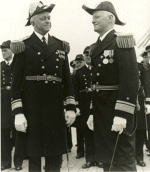 | 51k | On 17 September 1938, Arizona (BB-39) became the flagship for Battleship Division 1, when Rear Admiral Chester W. Nimitz (later to become Commander-in-Chief, Pacific Fleet) broke his flag on board. Detached 27 May 1939 to become Chief of the Bureau of Navigation, Nimitz was relieved on that day by Rear Admiral Russell Willson.
Rear Admiral Chester W. Nimitz and Rear Admiral Russell Willson, USN, are shown during the change of Command Ceremonies on Arizona, 26 May 1939. | USN / USNI photo.
Text courtesy of DANFS.
|
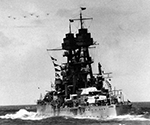 | 620k | Stern view of the Arizona (BB-39) shown beneath welcoming planes as the approaching fleet upon its completion of recent maneuvers and arrival in Hawaiian waters. Note, the photograph is curved. | USN photo # 80-G-1009378, courtesy of the National Museum of the U.S. Navy, via flickr.com.
|
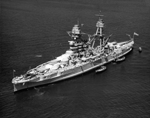 | 794k | Coming and goings of the Arizona (BB-39). | Photo i.d. courtesy of Frank Dengler & Richard Jensen.
Photo # 80G-651633 from NARA, College Park, Maryland, courtesy of Sean Hert.
|
 |
3.09k |
Five page booklet of Arizona (BB-39) general plans following her last rebuild at Puget Sound Naval Shipyard, April 1939.
Ships information and Inboard Profile, Outboard profile, superstructure decks and tripod platforms, Main Deck, Forecastle deck (AKA upper deck), and boat deck (AKA Superstructure Deck), Second Deck, Third Deck, First Platform, Second Platform, Hold, and Double bottom.
Last revision date June 3 1941. |
Text i.d. courtesy of David Perry.
Source: NARA II, College Park, Maryland.
PDF submitted by Tracy White @ Researcher @ Large. |
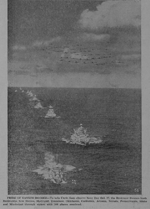
01yankeedoodle |
441k |
PRIDE OF YANKEE DOODLE-To help Uncle Sam observe Navy Day, 27 October 1939: the Destroyer Downes (DD-375) leads Battleships New Mexico (BB-40), Maryland (BB-46), Tennessee (BB-43), Oklahoma (BB-37), California (BB-44), Arizona (BB-39), Nevada (BB-36), Pennsylvania (BB-38), Idaho (BB-42) and Mississippi (BB-41) through waters with 100 planes overhead. |
Photo courtesy of umich.edu |
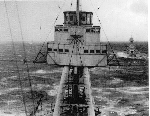 | 43k | Arizona's (BB-39) Maintop that housed the MK.20 Main Battery Director. The middle level was for Main battery Spotting and the lower Level housed the Secondary Battery Directors. | USN photo courtesy Pieter Bakels. |
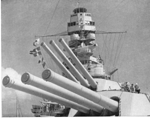 | 1.00k | Arizona's (BB-39) Main Battery. | USN photo courtesy Pieter Bakels. |
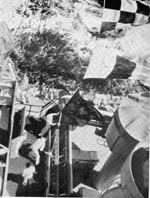 | 658k | Arizona's (BB-39) Flag Hoist. | USN photo courtesy Pieter Bakels. |
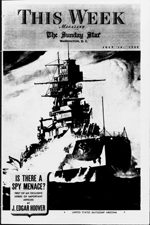
013940i | NR | IS THERE A SPY MENACE?
FIRST OF AN EXCLUSIVE SERIES OF IMPORTANT ARTICLES BY J. EDGAR HOOVER
UNITED STATES BATTLESHIP ARIZONA (BB-39). | Image and text provided by Library of Congress, Washington, DC.
Photo & text by Evening Star.[volume] [volume] (Washington, D.C.) 1854-1972, 14 July 1940, Image 83, via chroniclingamerica.loc.gov. |
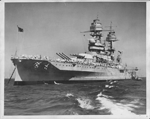 | 421k | U.S. FLAGSHIP ON WHICH PLOT IS REPORTED.SAN. PEDRO.CAL.
THIS IS A VIEW OF THE BATTLESHIP ARIZONA (BB-39) ON WHICH ALL LEAVES OF THE SAILORS WERE CANCELLED TODAY, REPORTEDLY BECAUSE OF THE DISCOVERY OF EVIDENCE OF A SABOTAGE PLOT AGAINST THE WARSHIP. NAVAL AUTHORITIES DECLINE TO COMMENT ON A REPORT THAT THERE HAS BEEN A PLAN TO DAMAGE THE FLAGSHIP WHICH IS SHOWN HERE AT ANCHOR IN LOS ANGELES HARBOR. THE ARIZONA IS REAR ADMIRAL RUSSELL WILLSON'S FLAGSHIP OF BATTLE DIVISION 1.
| Photo courtesy of Tommy Trampp. |
 | 1.02k | Arizona (BB-39) at Seattle in 1940. | USN photo courtesy Pieter Bakels. |
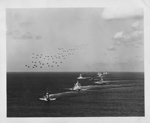 | 1.31k | Between 9 September 1940 - 13 September 1940 the Arizona (BB-39) was under way with other ships of the US Fleet for simulated fleet engagement. She is pictured here in company with the New Mexico (BB-40) & West Virginia (BB-48). | US Navy and Marine Corps Museum/Naval Aviation Museum, Photo No. 2008.104.001.235 courtesy of Alan Moore.
Text & photo i.d. courtesy of Alan Moore via
Battleship Arizona: An Illustrated History by Paul Stillwell, Annapolis, MD: Naval Institute Press, 1991. |
 | 367k | Column Right!
Arizona (BB-39), New Mexico (BB-40) & West Virginia (BB-48) and other ships of the Pacific Fleet taken during Fleet Ops in October 1940.
This photo and the following five are more than likely from the LIFE issue of 28 October 1940: "The Navy: LIFE Goes into Action with the U.S. Fleet".
One of the introductory paragraphs reads as follows:
"To show itself to the American people, the U.S. Navy has co-operated with LIFE in this issue. LIFE photographers and reporters examined naval schools, ammunition depots, bases, destroyers, battleships, the War College, etc. Finally a LIFE crew sailed on the U.S. Fleet maneuvers last month off Pearl Harbor in mid-Pacific."
| US Navy and Marine Corps Museum/Naval Aviation Museum, Photo No. 2008.104.001.235 courtesy of Alan Moore.
Text & photo i.d. courtesy of Alan Moore via Battleship Arizona: An Illustrated History by Paul Stillwell, Annapolis, MD: Naval Institute Press, 1991 & "The Navy: LIFE Goes into Action with the U.S. Fleet". Life. New York: Time, Inc., Vol 9 No 18 (28 October 1940). p23. |
 | 728k | Possibly the first of three photos with the caption "The enemy is sighted off right. Swiftly the battleships New Mexico (BB-40) and Arizona (BB-39) change direction." | Photographer: Carl Mydans, courtesy of life.time.com
|
 | 54k | First (not pictured here) of three photos with the caption "The enemy is sighted off right. Swiftly the battleships New Mexico (BB-40) and Arizona (BB-39) change direction."
The second photo (here) has the caption: "Wheeling into new position of line abreast, battleships move slowly while other ships speed into position."
Appended is the text that appeared on the photo credits page of that issue.
Carl Mydans, LIFE's photo-reporter who roamed battlefields in Finland and France from September 1939 to June 1940, now turns his lens on the U. S. Navy (see pp. 23—97). During one month with the Fleet in the Pacific, Mydans took pictures aboard a battleship, a cruiser, a destroyer, a submarine, a hospital ship and a repair ship. Mydans also spent some time in the brig of the Indianapolis (CA-35).
Early one morning he had climbed onto a platform over the Admiral's bridge, when a gust of wind blew sunshade and filter from his Zeiss Super-Ikonta camera. They fell near Vice Admiral Adolphus Andrews, commander of the Scouting Force. After lunch Mydans was served with a paper charging him with "willfully, maliciously and without justifiable cause "assaulting and attempting to strike with a dangerous weapon of German manufacture one Adolphus Andrews, Vice Admiral. With mock solemnity he was taken to the brig and locked up. Few moments later the entire wardroom, from executive officer down, descended and peered through the grille at Prisoner Mydans. When each had enjoyed a good laugh, Mydans was set free.
| Photo by Carl Mydans, Time, Inc, submitted courtesy Pieter Bakels.
Text & photo i.d. courtesy of Alan Moore. "The Navy: LIFE Goes into Action with the U.S. Fleet". Life. New York: Time, Inc., Vol 9 No 18 (28 October 1940). p.28 & 29. |
 | 496k | The third photo (here) is captioned:
"Battleships head directly toward the enemy over the horizon, ready to from line of battle either way." | Photo by Carl Mydans, Time, Inc, submitted courtesy Pieter Bakels. Text & photo i.d. courtesy of Alan Moore. "The Navy: LIFE Goes into Action with the U.S. Fleet". Life. New York: Time, Inc., Vol 9 No 18 (28 October 1940). p.28 & 29. |
 | 249k | A.A. Practice during Fleet Ops in October 1940. | USN photo courtesy Pieter Bakels. |
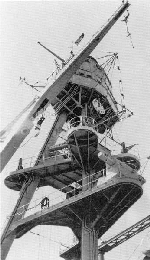 | 35k | Looking up at the mainmast probably during Fleet Ops in October 1940.
| USN photo courtesy Pieter Bakels. |
 | 217k | Field Day aboard a Pacific Fleet Battle wagon.
| US Navy and Marine Corps Museum/Naval Aviation Museum, Photo No. 2008.104.001.235 courtesy of Alan Moore.
|
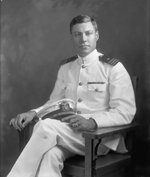 | 94k | Captain Harold Cecil Train was the Commanding Officer of the Arizona (BB-39) from 5 September 1940 to 5 February 1941.
| Photo courtesy of the Library of Congress via Bill Gonyo. |
 | 131k | Arizona (BB-39) with three YPs in the foreground... Probably December 1940 as there is work going on with her superstructure and the splinter shields have been constructed around her 5" guns but not been painted yet.
| USN photo courtesy of Tracy White @ Researcher @ Large.
|
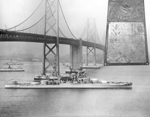 | 2.02k | Arizona (BB-39) passing under the Golden Gate Bridge, possibly for the last time. She does not yet have the MK 33 directors or the birdbath of her final configuration. | Text & photo courtesy of USS-Arizona-BB39-Ships-Data, Norman Friedman, Arthur D. Baker, III. Arnold S. Lott, Robert F. Sumrall, via Scott Koen & ussnewyork.com. |
 | 674k | Starboard profile of the Arizona (BB-39) at Puget Sound Navy Yard, 18 January 1941. The stern section of the Nevada (BB-36) and her tripod masts rise up behind the Arizona. | USN photo # 123-41 courtesy of Seattle NARA via Tracy White @ Researcher @ Large.
|
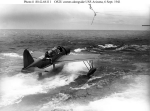 | 70k | Vought OS2U "Kingfisher" float plane, of Observation Squadron One (VO-1) Taxi's along side Arizona (BB-39), after a flight in the Hawaiian Operating area, 6 September 1941. Pilot is Lieutenant-Commander Welton D. Rowley, Commanding Officer of VO-1. Rear-seat man, Radioman 2nd Class E.L. Higley, is preparing to go out on the plane's wing to hook up the aircraft to the battleship's crane for recovery. The plane is numbered "1-O-1". | Official USN photo Naval History and Heritage Command # 80-G-66111, from the collections of the Naval Historical Center. |
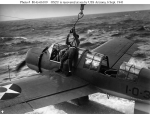 | 77k | Vought OS2U "Kingfisher" float plane, of Observation Squadron One (VO-1). Being recovered by Arizona (BB-39), after a flight in the Hawaiian Operating area on the morning of 6 September 1941. The pilot, Ensign Lawrence A. Williams, is holding the belt of his rear-seat man, Radioman 3rd Class G.H. Lane, who is hooking up the aircraft to the ship's crane for recovery. | Official USN photo Naval History and Heritage Command # 80-G-66109, from the collections of the Naval Historical Center. |
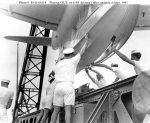 | 87k | Vought OS2U "Kingfisher" float plane is lowered onto the after catapult of Arizona (BB-39), in the Hawaiian Operating area, 6 September 1941. Note details of the plane's float, the catapult and crew uniforms. | Official USN photo Naval History and Heritage Command # 80-G-66114, from the collections of the Naval Historical Center. |
 | 72k | Arizona (BB-39) inboard profile, 1941. | Photo and text courtesy of U.S. Battleships: An Illustrated Design History by Norman Friedman. |
 | 259k | Three dimensional cutaway of the Arizona (BB-39). |
Photo courtesy of unlimiteddetails.com . |
 | 201k | Color print of the Arizona (BB-39) with PBY 5-A Catalina's flying overhead as the ship nears Diamond Head, Hawaii. | Photo contributed by Robert M. Cieri. |
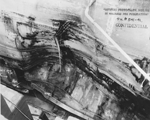 |
159k |
Damage on Arizona's (BB-39) port side blister following a collision with Oklahoma (BB-37) on the morning of 23rd October, 1941.
|
Source: NARA College Park, Bureau of Ships General Correspondence files, submitted by Tracy White @ Researcher @ Large. |
 | 98k | Oil on canvas painting by the artist Tom Freeman entitled "Arizona" showing the Arizona (BB-39) as she passes Diamond Head on 28 November 1941, with the Phelps (DD-360) in escort. | Photo and text courtesy of oldgloryprints.com
|
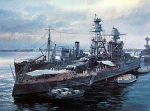 | 86k | Oil on canvas painting by the artist Tom Freeman entitled "Daybreak of Destiny", showing the Arizona (BB-39) moored
and the Vestal (AR-4) at Pearl Harbor, December 1941. Signed by artist Tom Freeman, Capt. Jim Miller (Arizona's most senior surviving officer), and Don Stratton (one of the few who escaped from the forward part of the ship). | Photo and text courtesy of usni.org
|
 | 682k | Oil on canvas painting by the artist Tom Freeman entitled "Last Mooring", showing the Arizona (BB-39) moored in front of the Nevada (BB-36) and behind the Oklahoma (BB-37). | Photo and text courtesy of oldgloryprints.com
|
 | 1.00k | Scheduled to receive tender availability, Arizona (BB-39) took the repair ship Vestal (AR-4) along side on Saturday, the 6th. | Text courtesy of DANFS.
LOC Photo courtesy of David Valenzuela's Battleship Arizona Book Pics via flickr.com.
|
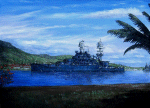 | 135k | Oil on canvas painting by the artist Wayne Scarpaci entitled "Come Into Port Greatly", showing the Arizona (BB-39) coming into Pearl Harbor for the last time. | Photo and text courtesy of artbywayne.com |
Attack on Pearl Harbor
|
 |
2.94k |
Japanese Attack on Pearl Harbor, 7 December 1941. Imperial Japanese Navy aircraft carriers in dawn fly-off for Pearl Harbor. |
Artwork by John Hamilton from his publication, "War at Sea," pg. 68-69.
USN photo # 80-142-H, courtesy of the U.S. Navy Art Gallery from the National Museum of the U.S. Navy, courtesy of flickr.com.
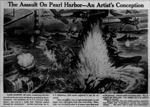
014325 |
NR |
The Assault On Pearl Harbor—An Artist's Conception
HANK BARROW, AP artist, reconstructs the battle at Pearl Harbor from information provided by Secretary Knox. One battleship, the Arizona (BB-39), (right center), was sunk by a bomb that "literally passed through the smokestack." Another battleship, the Oklahoma (BB-37), (left center,capsized. It can be repaired. Three destroyers (one in right foreground), an old target ship, and a mine layer also went down. Other ships were damaged, many U. S. planes were destroyed on the ground. Almost 2,900 servicemen died The attackers lost three subs (one midget sub is at extreme right) & 41 aircraft.
Knox said that after the initial surprise, American men fought with "magnificent courage and resourcefulness. The men's will to resist was tremendous...
|
Image and text provided by University of Florida.
Photo from The Key West Citizen. [volume] (Key West, Fla.) 1879-current, 22 December 1941, Image 1, via chroniclingamerica.loc.gov.
|
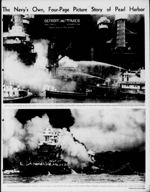
014316s |
2.14k |
The Navy's Own, Four-Page Picture Story of Pearl Harbor
Old Glory flying proudly in one of her darkest hours and over sailors at Pearl Harbor last 7 December risking their lives close up to the bomb-set flames roaring from both West Virginia (BB-48) and Tennessee (BB-43).
Slightly-damaged 31,000-ton Maryland (BB-46) (first battleship to rejoin the fleet after repairs) in Pearl Harbor's flames. Behind her is another battleship, at right the capsized battleship Oklahoma (BB-37). |
Image and text provided by Central Michigan University, Clark Historical Library.
Photo from Detroit Evening Times. (Detroit, Mich) 1921-1958, 06 December 1942, FINAL, Images 21, 22, 23, & 24, via chroniclingamerica.loc.gov.
|
 |
1.67k |
Battleship row in flames. |
Artwork by John Hamilton from his publication, "War at Sea," pg. 74-75.
USN photo # 80-142-I, courtesy of the U.S. Navy Art Gallery from the National Museum of the U.S. Navy, courtesy of flickr.com.
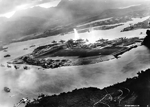 |
399k |
Photograph taken from a Japanese plane during the torpedo attack on ships moored on both sides of Ford Island shortly after the beginning of the Pearl Harbor attack. View looks about east, with the supply depot, submarine base and fuel tank farm in the right center distance. A torpedo has just hit West Virginia (BB-48) on the far side of Ford Island (center). Other battleships moored nearby are (from left): Nevada (BB-36), Arizona (BB-39), Tennessee (BB-43) (inboard of West Virginia), Oklahoma (BB-37) (torpedoed and listing) alongside Maryland (BB-46), and California (BB-44). On the near side of Ford Island, to the left, are light cruisers Detroit (CL-8) and Raleigh (CL-7), target and training ship Utah (BB-31) and seaplane tender Tangier(AV-8). Raleigh and Utah have been torpedoed, and Utah is listing sharply to port. Japanese planes are visible in the right center (over Ford Island) and over the Navy Yard at right. U.S. Navy planes on the seaplane ramp are on fire. Japanese writing in the lower right states that the photograph was reproduced by authorization of the Navy Ministry. |
Text courtesy of wikipedia.com.
Official USN photograph NH 50930.
|
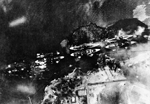 |
3.95k |
Vertical aerial view of "Battleship Row", beside Ford Island, during the early part of the horizontal bombing attack on the ships moored there. Photographed from a Japanese aircraft. Ships seen are (from left to right): Nevada (BB-36), Arizona (BB-39) with Vestal (AR-4) moored outboard; Tennessee (BB-43) with West Virginia (BB-48) moored outboard; Maryland (BB-46) with Oklahoma (BB-37) moored outboard; and Neosho (AO-23), only partially visible at the extreme right. A bomb has just hit Arizona near the stern, but she has not yet received the bomb that detonated her forward magazines. West Virginia and Oklahoma are gushing oil from their many torpedo hits and are listing to port. Oklahoma's port deck edge is already under water. Nevada has also been torpedoed.
Japanese inscription in lower left states that the photograph has been officially released by the Navy Ministry. Also at NHHC as NH 50472.
From the translated Japanese caption, "Alas, the spectacle of the American battleship Fleet in its Dying Gasp. The attack of our assault force was extremely accurate and achieved direct hits with all bombs. The leading ship of the Oklahoma Class is already half sunk. The Maryland type and the Pennsylvania type are blowing up from several direct hits. The ships crumble and their hulls are twisted and keeling over. Crude oil gushes forth fearfully. This view of the wretched enemy's capital ships which were converted into a sea hell was photographed from directly overhead by the heroes of our calm, valorous attack force." |
USN photo # 80-G-30551, courtesy of the National Museum of the U.S. Navy, via flickr.com. |
 |
1.25k |
Japanese post card of Battleship Row during 7 December attack & the attack on the Arizona (BB-39). |
Photo courtesy of Arnold Putnam.
|
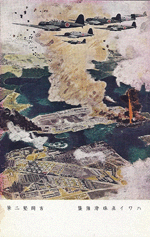 |
1.01k |
Japanese post card of bombers over Pearl Harbor, 7 December 1941. |
Photo courtesy of Arnold Putnam.
|
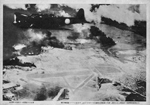 |
3.24k |
Japanese attack on Pearl Harbor - Hickam Field. |
Photo courtesy of Arnold Putnam.
| 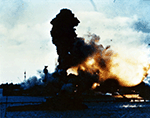 | 1.14k | The death of the Arizona (BB-39), 0805, 7 December 1941. The forward magazines of Arizona explode after she was hit by a Japanese bomb, 7 December 1941. Frame clipped from a color motion picture taken from on board Solace (AH-5). | Official USN photo Naval History and Heritage Command # 80-G-K-13513, now in the collections of the National Archives. |
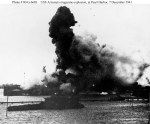 | 71k | The death of the Arizona (BB-39), 0805, 7 December 1941. The forward magazines of Arizona explode after she was hit by a Japanese bomb, 7 December 1941. Black and white photo from a picture taken from on board Solace (AH-5). Photo shows greater contrast than the color one above. | Official USN photo Naval History and Heritage Command # 80-G-6683, now in the collections of the National Archives. |
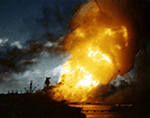 | 1.90k | The forward half of the ship is engulfed in flames that shoot hundreds of feet into the air. The heat is so intense that the only remains of Rear Admiral Isaac C. Kidd, the Commander of Battleship Division One is his Naval Academy class ring, welded to the steel deck of the armored conning tower. These color shots were taken from a rare color motion picture shot by an Army Doctor visiting the Solace (AH-5). | Official USN photo Naval History and Heritage Command # 80-G-K-13512, from the collections of the Naval Historical Center.
Text courtesy of ibiblio.org via Bill Gonyo. |
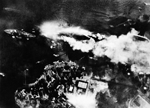 | 3.52k | Vertical aerial view of "Battleship Row", beside Ford Island, soon after Arizona (BB-39) was hit by bombs and her forward magazines exploded. Photographed from a Japanese aircraft. Ships seen are (from left to right): Nevada (BB-36); Arizona (burning intensely) with Vestal (AR-4) moored outboard; Tennessee (BB-43) with West Virginia (BB-48) moored outboard; and Maryland (BB-46) with Oklahoma (BB-37) capsized alongside. Smoke from bomb hits on Vestal and West Virginia is also visible.
Japanese inscription in lower left states that the photograph has been reproduced under Navy Ministry authorization. Also at NHHC as NH 30552.
Translated Japanese caption reads, "Capsizing, Sinking, Burning, the anchorage of the American capital ships is changed to a scene of carnage. In rapid succession, the enemy war vessels were set ablaze by the violent bombing attacks which followed the torpedo attacks. The special service ship in the capital ship anchorage has already been sunk. The violent smoke from the exploding powder magazine is rising from a vessel of the Oklahoma Class alongside. A Pennsylvania class ship, capsized and sinking, shows its bottom. Two ships the California class and the Maryland class are in flames from direct bomb hits. In the upper right-hand part of the photograph are what appear to be several rescue ships, darting right and left. |
USN photo # 80-G-30552, courtesy of the National Museum of the U.S. Navy, via flickr.com.
| 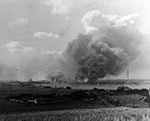 |
842k |
View of Battleship Row from a site near Mobile Base Hospital #2 during the Japanese Attack on Pearl Harbor on 7 December 1941. Nevada (BB-36) is in the center distance. Large column of smoke to the left of her is from Shaw (DD-373), burning in the floating drydock YFD-2. "Battleship Row" is in the right center. Largest mass of smoke there comes from Arizona (BB-39). | USN photo # 80-G-32892 from the National Museum of the U.S. Navy via flickr.com. |
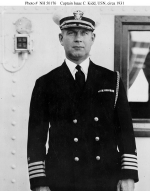 | 60k | Captain Isaac C. Kidd, USN. Photographed on board Argonne (AS-10), circa 1931. He was then serving as Chief of Staff to the Commander, Base Force, U.S. Fleet, Rear Admiral Henry H. Hough, USN.
| Naval History and Heritage Command # NH 50176, now in the collections of the National Archives.
|
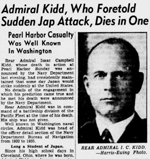
013929a | NR | Admiral Kidd, Who Foretold Sudden Jap Attack, Dies in One
Pearl Harbor Casualty Was Well Known In Washington. | Image and text provided by Library of Congress, Washington, DC.
Photo & text by Evening Star.[volume] [volume] (Washington, D.C.) 1854-1972, 11 December 1941, Image 4, via chroniclingamerica.loc.gov. |
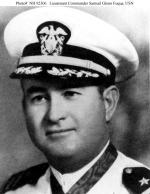 | 93k | Commander Samuel Glenn Fuqua, USN, who was awarded the Medal of Honor for heroism and distinguished conduct in action while serving on board Arizona (BB-39) during the 7 December 1941 Japanese raid on Pearl Harbor. He was a Lieutenant Commander at that time. Halftone reproduction, copied from the official publication "Medal of Honor, 1861-1948, The Navy", page 189. | Naval History and Heritage Command # NH 92306, now in the collections of the National Archives.
|
 | 69k | Rear Admiral Issac C. Kidd, USN. Portrait in oils by Rishell, 1942. The original painting measures 48 inches by 38 inches. | Naval History and Heritage Command # NH 85226-KN, courtesy of the U.S. Navy Art Collection, Washington, D.C. |
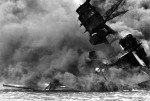 | 899k | The forward superstructure and Number Two 14"/45 triple gun turret of the sunken Arizona (BB-39), afire after the Japanese raid, 7 December 1941. The foremast is leaning as a result of the collapse of the hull structure below its front leg, following the explosion of the ship's forward magazines. | Text from Naval History and Heritage Command # NH 97379, from the collections of the Naval Historical Center.
Photo from NARA FILE #: 080-G-32420, courtesy of dodmedia.osd.mil, Defense Visual Information Center. |
|
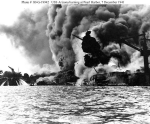 | 83k | Arizona (BB-39) sunk and burning furiously, 7 December 1941. Her forward magazines had exploded when she was hit by a Japanese bomb. At left, men on the stern of Tennessee (BB-43) are playing fire hoses on the water to force burning oil away from their ship. | Official USN photo Naval History and Heritage Command # 80-G-19942, from the collections of the Naval Historical Center. |
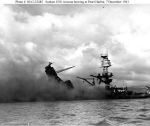 | 60k | Arizona (BB-39) sunk and burning after the Japanese attack, 7 December 1941. Her forward magazines had exploded when she was hit by a Japanese bomb, resulting in the collapse of structure below her two forward turrets and superstructure. The tug Hoga (YT-146) is alongside, fighting fires on board the wrecked battleship. | Submitted by Scott Dyben.
Official USN photo Naval History and Heritage Command # 80-G-32485, from the collections of the Naval Historical Center. |
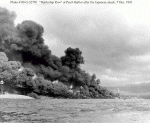 | 58k | View of "Battleship Row" during or immediately after the Japanese raid. Arizona (BB-39) is sunk and burning at right. West Virginia (BB-48) is in the center, sunk alongside Tennessee (BB-43), with oil fires shrouding them both. The capsized Oklahoma (BB-37) is at the left, alongside Maryland (BB-46). | Submitted by Scott Dyben.
Official USN photo Naval History and Heritage Command # 80-G-32485, from the collections of the Naval Historical Center. |
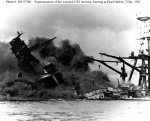 | 82k | The forward superstructure and midships gun positions of the sunken Arizona (BB-39), afire after the Japanese raid, 7 December 1941. At right are the ship's mainmast and boat cranes, which were beyond the areas wrecked by the explosion of her forward magazines. | Official USN photo Naval History and Heritage Command # NH 97380, from the collections of the Naval Historical Center. |
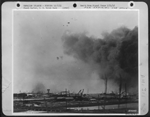
013907b
| 1.94k |
First Army Photo Of Bombing Of Hawaii, 7 December 1941. Enemy Planes Dodge Through A Hail Of Shrapnel Fire Over Pearl Harbor, U.S. Naval Base, T.H. Smoke At The Right Is Over The Burning Battleship Arizona (BB-39). Filed - War Theatre #22 (Hawaiian Islands) | National Archives Identifier: 193835509
Local Identifier: 342-FH-3A41311-64132AC.
Photo courtesy of catalog.archives.gov
| 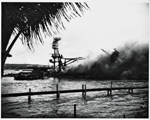
013908b | 7.59k | Sunk and burning at Pearl Harbor, Hawaii, on 7 December 1941, after her forward magazines exploded when she was hit by Japanese bombs. | Photo via Bob Canchola. |
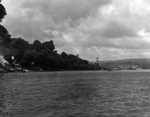 |
1.21k |
Burning and damaged ships at Pearl Harbor after the attack. Visible left to right: Arizona (BB-39) and West Virginia (BB-48). |
USN photo # 80-G-32729, courtesy of the National Museum of the U.S. Navy, via flickr.com.
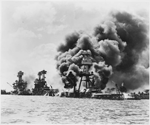 | 610k | Aftermath of the Japanese sneak attack on these three stricken U.S. battleships; from left to right: West Virginia (BB-48) (severely damaged), Tennessee (BB-43) (damaged), and the Arizona (BB-39) (sunk). | NARA #(NLR-PHOCO-A-65458) courtesy of fdrlibrary.marist.edu |
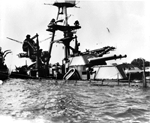 | 590k | Port quarter view of the Arizona (BB-39) looking forward. Rear gun turret and superstructure details, after her sinking, are easily visible.
| Photo courtesy of Library of Congress; H.A.E.R. HI,2-HONLU,31—4, via Mike Green. |
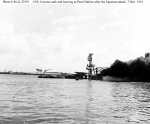 | 65k | Arizona (BB-39) sunk and burning, with the National Ensign still flying at her stern. | Official USN photo Naval History and Heritage Command # 80-G-32591, from the collections of the Naval Historical Center. |
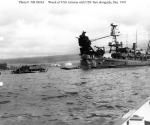 | 91k | Burned out and sunk at Pearl Harbor, Hawaii, after her fires were out, 9 December 1941. She was destroyed when bombs detonated her forward magazines during the Japanese raid of 7 December 1941. Tern (AM-31) and Navajo (AT-64) are alongside. Solace (AH-5) is in the center distance. | Official USN photo Naval History and Heritage Command # NH 83063, from the collections of the Naval Historical Center. |
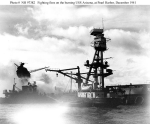 | 90k | A harbor tug (YT) and a garbage lighter (YG) fighting fires on the battleship, after she was sunk at Pearl Harbor by Japanese bombs on 7 December 1941. This photograph may have been taken on the following day. | Official USN photo Naval History and Heritage Command # NH 97382, from the collections of the Naval Historical Center. |
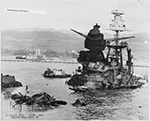 | 520k | Burned out and sunk in Pearl Harbor on 10 December 1941, three days after she was destroyed during the 7 December Japanese raid. Ships in the background are Saint Louis (CL-49), in center, and the hulked minelayer Baltimore (CM-1) at left. | Official USN photo Naval History and Heritage Command # NH 63918, now in the collections of the National Archives. |
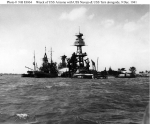 | 89k | Sunk at Pearl Harbor, Hawaii, after her fires were out, 9 December 1941. She was destroyed during the Japanese raid of 7 December 1941. Navajo (AT-64) and Tern (AM-31) are alongside, spraying water to cool her burned out forward superstructure and midships area. In the left center distance are the masts of West Virginia (BB-48) and Tennessee (BB-43). | Naval History and Heritage Command # NH 83064, now in the collections of the National Archives. |
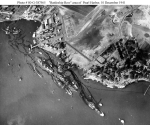 | 116k | Aerial view of "Battleship Row" moorings on the southern side of Ford Island, 10 December 1941, showing damage from the Japanese raid three days earlier. In upper left is the sunken California (BB-44), with smaller vessels clustered around her. Diagonally, from left center to lower right are: Maryland (BB-46), lightly damaged, with the capsized Oklahoma (BB-37) outboard. A barge is alongside Oklahoma, supporting rescue efforts.Tennessee (BB-43), lightly damaged, with the sunken West Virginia (BB-48) outboard. Arizona (BB-39), sunk, with her hull shattered by the explosion of the magazines below the two forward turrets. Note dark oil streaks on the harbor surface, originating from the sunken battleships. | Official USN photo Naval History and Heritage Command # 80-G-387565, now in the collections of the National Archives. |
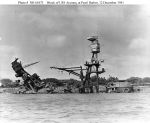 | 86k | Wrecked at Pearl Harbor, 12 December 1941. Her forward magazines had exploded, destroying the ship, when she was hit by bombs during the 7 December 1941 Japanese attack. By the date of this photo, the National Ensign was being flown from her mainmast, rather than at the stern. | Naval History and Heritage Command # NH 64473, now in the collections of the National Archives. |
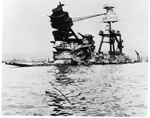 | 476k | The burned-out, sunken wreck of Arizona (BB-39), photographed some days after the attack. | Photo courtesy of the National Naval Aviation Museum via Bill Gonyo. |
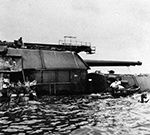 |
991k |
Divers working around aft turrets of Arizona (BB-39), sunk during the Japanese attack on Pearl Harbor, Territory of Hawaii, on 7 December 1941. | USN photo # 80-CF-1061-3 from the National Museum of the U.S. Navy via flickr.com. |
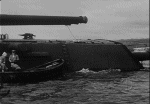 | 69k | A small boat alongside the water level turrets of the blown up Arizona (BB-39), sometime between December 1941 and early February 1942. | Photo courtesy of periscopefilm.com. Text i.d. courtesy of Tracy White @ Researcher @ Large.
| 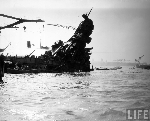 | 122k | Sunken wreckage of the battleship Arizona (BB-39) destroyed during Japanese surprise attack on Pearl Harbor. | Photo courtesy of life.time.com |
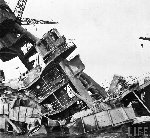 | 203k | Sunken wreckage of the battleship Arizona (BB-39) destroyed during Japanese surprise attack on Pearl Harbor. | Photo courtesy of life.time.com |
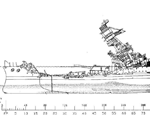 | 51k | Two views of the ship at the bottom of Pearl Harbor. | USN photo courtesy of Scott Koen & ussnewyork.com. |
 |
831k |
Salvage Schematic, February 1942.
This drawing was found by researcher Kathleen O'Connor at the San Bruno National Archives branch; it shows Arizona's (BB-39) state after the attack. |
Source: NARA II, College Park, Maryland.
PDF submitted by Tracy White @ Researcher @ Large. |
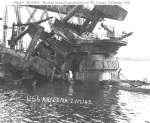 | 134k | View of the sunken battleship's forward superstructure, showing damage caused when her forward magazines exploded during the 7 December 1941 Japanese raid on Pearl Harbor, Hawaii. The photograph was taken on 17 February 1942, as work began to remove the collapsed wreckage. The crane in the left background was then removing Arizona's mainmast. | Naval History and Heritage Command # NH 83993, now in the collections of the National Archives. |
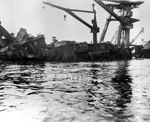 | 596k | Port side view of deck crane and main deck details on the Arizona (BB-39) on 17 February 1942.
| Photo courtesy of Library of Congress; Library of Congress, HAER HI,2-HONLU,31--5, via Mike Green. |
 | 2.06k | Rear turrets of the Arizona (BB-39) with the West Virginia (BB-48) in the background. | LOC Photo courtesy of David Valenzuela's Battleship Arizona Book Pics via flickr.com.
| 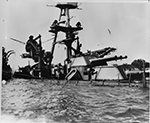 | 721k | Different angle of the above. | National Archives photo courtesy of commons.wikimedia.org. |
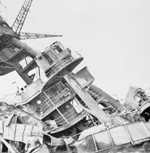 | 401k | Wreckage of the forward tripod mast. | LOC Photo courtesy of David Valenzuela's Battleship Arizona Book Pics via flickr.com.
| 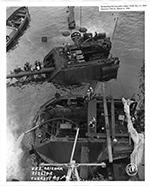 | 568k | 25 February 1942: Removing the 14" guns from Turrets #3 & 4. Of note is the amount of water being pumped out from both turrets and signs of oil on the water.
| Text courtesy of ibiblio.org via Bill Gonyo.
National Archives Identifier: 296940
Photo courtesy of wikipedia.com |
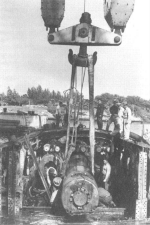 | 96k | The center gun of the Arizona's(BB-39) turret 4 is pulled free on 25 February, 1942. The turret had been rotated toward Ford Island to provide clearance for the gun's removal. | From the book "Resurrection-Salvaging the Battle Fleet at Pearl Harbor" by Dan Madsen.
National Archives photo courtesy of Mike Green. |
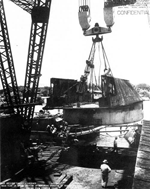 | 504k | Rear view of the upper rotating section of one of Arizona's (BB-39) aft turrets. The turret section has just been removed from it's shipboard position for removal and scrapping. | Source: U.S. Navy, Photo No. Unknown, via Mike Green. |
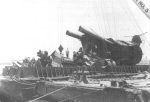 | 79k | The toppled, blackened foremast of the Arizona (BB-39) lies on a barge, 6 May, 1942. The foremast, surrounded by dense black smoke, would be one of the enduring images of the attack. But, in the spring of 1942, it was just so much scrap metal to be removed. | From the book "Resurrection-Salvaging the Battle Fleet at Pearl Harbor" by Dan Madsen.
National Archives photo courtesy of Mike Green. |
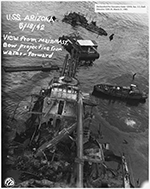 | 745k | View from main mast. Bow projecting from water- forward, 18 May, 1942. | National Archives photo # 296936 courtesy of commons.wikimedia.org. |
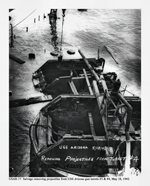
013917c | 4.23k | Arizona (BB-39) salvage removing projectiles from gun turrets #3 and #4, 18 May 1942. | National Parks Gallery courtesy of Bob Canchola. |
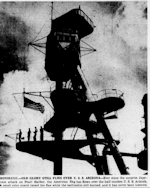 | NR | HONOLULU.—OLD GLORY STILL FLIES OVER ARIZONA (BB-39)-Ever since the surprise Japanese attack on Pearl Harbor, the American flag has flown over the half-sunken Arizona. A small color guard raised the flag while the battleship still burned, and it has never been lowered. | Official Navy Photo from A. P. Wirephoto.
Image and text provided by Library of Congress, Washington, DC.
Photo & text by Evening Star. ([volume] (Washington, D.C.) 1854-1972, 26 May 1942, Image 1, courtesy of chroniclingamerica.loc.gov.
|
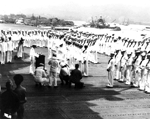 |
806k |
Admiral Chester W. Nimitz presents awards on the flight deck of the carrier Enterprise (CV-6) moored at Pearl Harbor on 5/27/1942. Note the battleship Oklahoma (BB-37) (capsized, nearest to camera) & West Virginia (BB-48) & Arizona (BB-39) behind her.
One of those visible receiving a medal is Dorie Miller, an African-American messman who was awarded the Navy Cross for his heroic actions on board the battleship West Virginia (BB-48) during the Pearl Harbor attack. |
Photo from the collection of Robert L. Lawson.
US Navy and Marine Corps Museum/Naval Aviation Museum, Photo No. 1996.488.272.007. |
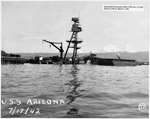
013992 | 756k | Arizona (BB-39) on 17 July 1942.
| NARA Photo # 296944 courtesy of Bob Canchola. |
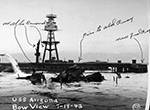 |
1.24k |
Arizona (BB-39), bow view, 19 July 1942. |
USN photo # 19-LCM-BB39-1-3, courtesy of the National Museum of the U.S. Navy, via flickr.com. |
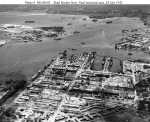 | 106k | Pearl Harbor, Oahu, Territory of Hawaii view looking northward, with the Navy Yard industrial area in the foreground and the Marine Barracks in the lower right, 28 July 1942. Ford Island is at left, with Oklahoma (BB-37) and Arizona (BB-39) under salvage nearby. San Diego (CL-53) is in the upper center.
West Virginia (BB-48) is in Drydock Number One, in the lower left, and California (BB-44) is alongside the wharf at the extreme right. Cruisers alongside the pier in right center are Northampton (CA-26) (left) and Pensacola (CA-24). Submarines alongside 1010 Dock, just beyond Drydock # 1, are Trout (SS-202), Pollack (SS-180), Dolphin (SS-169) and Cachalot (SS-170).
Note camouflage on many of the Navy Yard's buildings.
| Official USN photo # NH 84002, from the collections of the Naval Historical Center, courtesy of the Naval Historical Foundation, Collection of The Honorable James V. Forrestal.
|
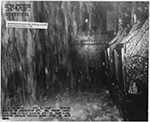 | 562k | Removal of ammunition aft. #4 turret handling room (D-411) looking aft on port side, showing leakage through water shed on main deck, 5 October 1942. | National Archives photo # 296941 courtesy of commons.wikimedia.org. |
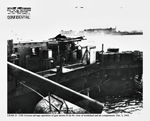
013915b | 3.00k | Arizona (BB-39) salvage operation of gun turrets #3 and #4, view of workshed and air compressors, 5 October 1942. | National Parks Gallery courtesy of Bob Canchola. |
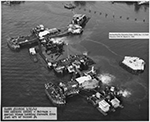 | 533k | Salvage Aerial views looking forward from just aft of turret 4, 21 March 1943. | National Archives photo # 296931 courtesy of commons.wikimedia.org. |
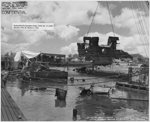 | 607k | Lifting underwater wreckage aft of conning tower foundation, 19 April 1943. | Photo courtesy of warbirds.com via Ron Reeves (of blessed memory).
| 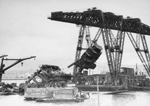 | 880k | Arizona's (BB-39) foremast being removed, circa 1943. | LOC Photo courtesy of David Valenzuela's Battleship Arizona Book Pics via flickr.com.
|
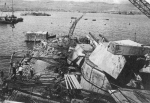 |
161k |
6 May 1943 photo taken onboard the Oklahoma (BB-37), looking aft showing her quarterdeck and rear turrets. A good photo showing the still attached cables around both turret barbettes. In the background, the above water remains of the Arizona are all but gone. Guns from this turret were later embarked on Nevada (BB-36) and fired in anger against the Japnese at Iwo Jima and Okinawa.
|
From the book "Resurrection-Salvaging the Battle Fleet at Pearl Harbor", by Dan Madsen. National Archives photo courtesy of Mike Green.
Partial text courtesy of ibiblio.org via Bill Gonyo. |
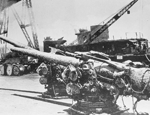 | 247k | Two of Arizona (BB-39) mud encrusted 5"/51 after being removed. | LOC Photo courtesy of David Valenzuela's Battleship Arizona Book Pics via flickr.com.
| 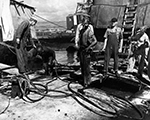 | 763k | Members of the diving crew emerge from water-filled compartments of the sunken battleship Arizona (BB-39) at Pearl Harbor, 25 May 1943. They are removing elements of the ships armament and other items for reuse. Arizona had been sunk in the 7 December 1941 Japanese air raid. Her hull was left where she sank, after removal of most of her superstructure and salvage of her after 14" gun turrets and other guns. | Official USN photo Naval History and Heritage Command # NH 64303, from the collections of the Naval Historical Center. |
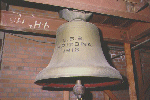 | 23k | The Preservation of the Arizona (BB-39) bell in this tower is dedicated to the memory of the men who lost their lives on Arizona in the attack on Pearl Harbor 7 December 1941.
This bell is one of the two original bells salvaged from the Arizona in 1941. In 1944, Wilber L. Bill Bowers, UA Class of 1927, discovered this bell about to be melted down at the Puget Sound Naval Yard in Bremerton, Washington. Bowers saved the bell from destruction and was instrumental in acquiring the bell for the University of Arizona shortly after World War II.
The bell arrived on campus in July 1946. On 17 November 1951 the bell was rung for the first time in the clock tower of the then-new Memorial Student Union Building. The bell was rung on special occasions for the next 50 years until that clock tower and Student Union were razed to make way for the present day facility completed in 2002.
The bell was installed in this clock tower on 16 August 2002. Bill Bowers, at the age of 99, was given the honor of ringing the bell for the first time in its new belfry on 11 September 2002. This bell is to be rung seven times on the third Wednesday of every month at 12:07 p.m. to honor the achievements of the University of Arizona and its community. It is traditionally rung by the Student Body President on the Sunday before Pearl Harbor Day, on the Student Union's birthday (18 November), and after Wildcat athletic victories (over any team except other Arizona schools).
Effective Wednesday, 16 April 2003, the Arizona Bell will be rung for significant University achievements on the third Wednesday each month. This includes academic achievements and awards for which a University of Arizona student, faculty or staff has received recognition in the previous thirty days. The Arizona Bell will be rung 7 times at 12:07pm in recognition of these outstanding achievements.
The other original bell is on display at the Arizona Memorial in Pearl Harbor, Hawaii. The photo was taken when the bell was originally mounted indoors. Since then it was moved to an outdoor bell tower.
| Information & photo from the University of Arizona, courtesy of Bill Gonyo. |
 | 144 | Had Arizona (BB-39) survived the attack on Pearl Harbor, she would have been similarly altered to this rendering. Note the SC air search and MK3 fire control radar antennas, the MK 37 fire control directors and twin 5/inch 38 gun mounts, the 1.1-inch and 20mm machine guns, and the measure 12 camouflage painting scheme. | Text & drawing by Alan E. Chesley, courtesy of Leeward Publications, P.O. Box 149, Annapolis MD 21404.
|
 | 71k | The Arizona (BB-39) after turrets were determined to be salvageable after her sinking. The Army in 1943 intended to incorporate these turrets into the coastal defense of Hawaii. Named Batteries Pennsylvania and Arizona, they were to be placed on the tip of Mokapu Peninsula, to cover the eastern portions of Oahu, and on Kahe Point, to cover the south and west, respectively.
Only battery Pennsylvania was completed and it was test fired on V-J day when it instantly became obsolete.
| Courtesy of Leeward Publications, P.O. Box 149, Annapolis MD 21404.
|
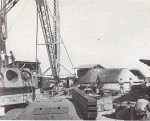 | 131k | Here armor is being assembled for battery Pennsylvania. | Courtesy of Leeward Publications, P.O. Box 149, Annapolis MD 21404.
|
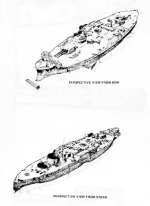 | 33k | Drawing from underwater survey conducted on Arizona (BB-39) showing her lying on the bottom. | Courtesy of the National Park Service. |
 | 397 | Drawing from underwater survey conducted on Arizona (BB-39) showing her lying on the bottom and detailing her damage. | Courtesy of the National Park Service. |
 | 161k | Damage to the Arizona (BB-39) from the attack and salvage operations. This image shows the current state of the Arizona, compared to a drawing of its pre-war condition in the background. Note in particular the way the two forward turrets have dropped.
The exploding magazines were directly under these turrets and destroyed the structural support for the gun turrets and barbettes on which they rested. The foremast toppled forward for the same reason. During salvage operations, divers attempting to enter this area from further aft reported that the ship's decks gradually pinched together until further progress forward became impossible.
Salvage operations involved removing the two main gun turrets aft, all of the ships superstructure and the guns from turret two. In the area of the most damage, the hull above the ship's main armor belt is missing, apparently as a combination of the explosion and subsequent salvage which involved the removal of metal from the hull that was projecting out from the side of the ship. The plans of the sunken Arizona are from the publication, Submerged cultural resources study. Arizona Memorial and Pearl Harbor national historic landmark, the report by the National Park Service on the survey work they did during the 1980's. The background drawing is adapted from Breyer, Siegfried. Battleships and Battle Cruisers, 1905-1970. | The University of Arizona Library |
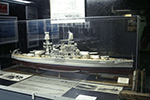 | 547k | Model shows the Arizona (BB-39) as she would have looked before the Pearl Harbor attack. Photographed on board the Yorktown (CV-10) at the Patriot's Point Maritime Museum in Charleston, SC. | Image and text provided by Arizona State Library, Archives and Public Records; Phoenix, AZ.
Photo from U.S. Naval History and Heritage Command Photograph courtesy of the National Museum of the U.S. Navy via flickr.com. |
Memorial
|
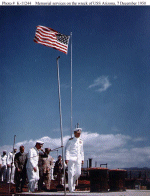 | 84k | Admiral Arthur W. Radford, USN, Commander in Chief, Pacific, and CinC, Pacific Fleet leads the procession during memorial services on board the wreck of Arizona (BB-39), 7 December 1950, on the 9th anniversary of the Japanese attack on Pearl Harbor. | Official USN photo Naval History and Heritage Command # 80-K-11244, from the collections of the Naval Historical Center. |

013171v | 756k | Arizona (BB-39) on bottom left and Utah (AG-16) on upper right. View of Ford Island in 1952. | Photo courtesy of Ray D. Bean Collection via Yu Chu. |
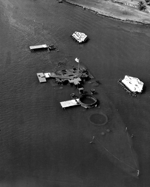 | 492k | Aerial view of the hull of the Arizona (BB-39), as seen sometime in the 1950s, prior to the construction of the Arizona Memorial. | Photo courtesy of US Navy and Marine Corps Museum/Naval Aviation Museum, Photo No. 1996.488.029.056a via Mike Green. |
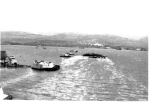 | 46k | View of the Arizona (BB-39) from the flight deck of Essex (CV-9) in 1954. | Contributed by AT3 Richard J. Havener. |
|
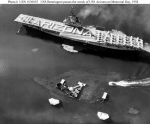 | 86k | Bennington (CVA-20) passes the wreck of Arizona (BB-39) in Pearl Harbor, Hawaii, on Memorial Day, 31 May 1958. Bennington's crew is in formation on the flight deck, spelling out a tribute to the Arizona crewmen who were lost in the 7 December 1941 Japanese attack on Pearl Harbor. Note the outline of Arizona's hull and the flow of oil from her fuel tanks. | Official USN photo Naval History and Heritage Command # NH 1036055, from the collections of the Naval Historical Center. |
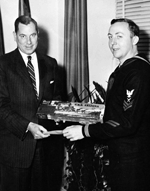 |
317k |
Secretary of the Navy Contributes to Arizona Memorial Fund Campaign. The Honorable Thomas S. Gates, Jr., Secretary of the Navy presents Robert E. Fudge, Yeoman First Class, U.S. Navy, with a contribution to the nation-wide Arizona Memorial Fund. Secretary Gates received a model of the historic ship in return. The fund was started by the Pacific War Memorial Commission to create a permanent memorial of the famous battleship which was sunk on 7 December 1941 at Pearl Harbor. Yeoman Fudge is the Deputy Chairman of the Navy's Fleet Reserve Association's Special Committee to enshrine Arizona (BB-39). The presentation was made in the Secretary's office on 21 November 1958. |
USN photo # USN 710304, courtesy of the National Museum of the U.S. Navy, via flickr.com.
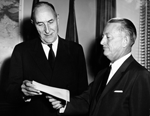 |
676k |
Secretary of the Navy Receives Check for Arizona Memorial. Mr. H. Tucker Grate, Chairman of the Pacific War Memorial Commission, presents a check for $26,129 to Secretary of the Navy William B. Franke. The check will cover cost of preparing the architectural and engineering drawing for the prosposed Arizona Memorial at Pearl Harbor, Hawaii. When presented the check, Secretary Franke remarked, "It is a wonderful thing indeed to know that construction is about to begin on a fitting monument to the 1102 men who lie intombed in Arizona (BB-39)." Mr. Grate informed the Secretary that this check is part of $300,000 now available to the Navy, on an "as-needed" basis, for initial construction costs of the memorial. The ultimate goal of the Pacific War Memorial Commission is one million dollars, 17 September 1959.
|
USN photo # USN 710305, courtesy of the National Museum of the U.S. Navy, via flickr.com.
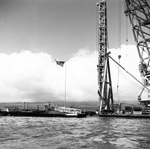 | 695k | Late 1950s view of early construction on the Arizona Memorial. | Photo courtesy of US Navy and Marine Corps Museum/Naval Aviation Museum, Photo No.1996.488.029.081 via Mike Green. |

013911b
| NR |
PROPOSED USS ARIZONA MEMORIAL
Artist’s conception of the proposed Arizona Memorial at Pearl Harbor, scheduled for dedication 7 December 1960.The Pacific fleet battleship was sunk by a single bomb in the 7 December 1941, attack that triggered the United States entry into World War 11. A rectangular concrete facade will stretch 186 feet from the outboard side of the sunken battleship to nearby Ford Island spanning the present exposed main deckhouse. The memorial will house a museum and a ceremonial bridge which will accommodate 200 persons. | U. S. Navy Photo.
Image and text provided by Library of Congress, Washington, DC.
Photo from the Evening Star. [volume] (Washington, D.C.) 1854-1972, 04 December 1959, Image 7 courtesy of chroniclingamerica.loc.gov.
| 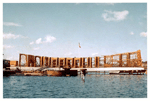 | 539k | Arizona Memorial under construction, late 1961-1962. | Photo by Don Boyer via Yu Chu.
| 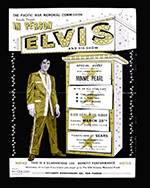 | 191k | How Elvis Helped Save the Arizona Memorial. | Link courtesy of USNI NEWS via Tommy Trampp. |
 | 988k | Artist conception of the newly completed Arizona Memorial at Pearl Harbor, Hawaii. Dedication ceremony for the memorial will take place on Memorial Day, 30 May 1962. Guest Speaker at the ceremony will be Colin E. Teague, Chairman, House Veteran's Affairs Committee. Special guests will be surviving families of the men entombed and survivors of Arizona (BB-39) . | USN photo # USN 711065, from the National Museum of the U.S. Navy, courtesy of flickr.com.
| 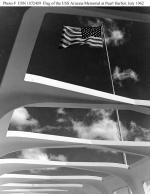 | 75k | The U.S. Flag flies over the memorial, as seen from its interior, July 1962. | Official USN photo Naval History and Heritage Command # 80-G-1072409, from the collections of the Naval Historical Center. |
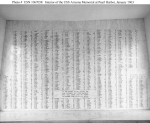 | 83k | Arizona Memorial Pearl Harbor, Hawaii. The marble northwestern interior wall of the memorial, with the names of the men lost with Arizona during the Japanese attack on Pearl Harbor, 7 December 1941. Photographed by PH2 Thomas on 24 January 1963. | Official USN photo Naval History and Heritage Command # USN 1067058, from the collections of the Naval Historical Center. |
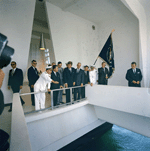 | 778k | President John F. Kennedy visits the Arizona Memorial at Pearl Harbor in Honolulu, Hawaii, 9 June 1963. Left to right: unidentified; White House Secret Service agent, Gerald A. "Jerry" Behn; Commander in Chief of the U.S. Pacific Command (CINCPAC), Admiral Harry D. Felt; Senator Daniel Inouye (Hawaii); unidentified; President Kennedy; Governor John A. Burns of Hawaii; Representative Spark M. Matsunaga (Hawaii); Deputy Chief of Naval Operations, Admiral U. S. Grant Sharp, Jr.; White House Secret Service agents, Tony Sherman and Ron Pontius. [Blemishes on image are original to the negative.] JFK would later lay a wreath. | Photo # JFKWHP-KN-C28989 & JFKWHP-KN-C29004 by Robert Knudsen. White House Photographs. John F. Kennedy Presidential Library and Museum, Boston, courtesy of jfklibrary.org.
| 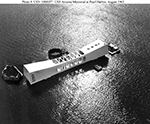 | 184k | Photographed on 21 August 1963, looking toward the morning sun. Photographed by PH1 R.C. Moen. | Official USN photo Naval History and Heritage Command # USN 1088057, from the collections of the Naval Historical Center. |
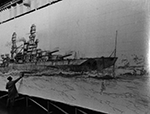 |
970k |
Navy Museum, Washington Navy Yard, Washington, D.C. (Now National Museum of the U.S. Navy). Lieutenant John Roach examines his painting, a 16 x 52 foot mural of Arizona (BB-39) . The mural hangs at the Memorial Museum at Pearl Harbor. Photographed by PH2 Richard McDill, received April 1981. Photograph received October 1968. | USN photo # 428-GX-USN 1180591 now in the collections of the National Archives, from the National Museum of the U.S. Navy via flickr.com. |
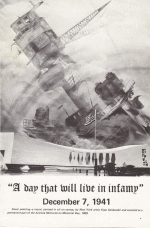 | 214k | Mural Dedication Program for the Arizona Memorial. The mural was painted by New York artist Kipp Soldwedel. It was unveiled and dedicated on Memorial Day 1969. | Photo courtesy of Robert M. Cieri. |
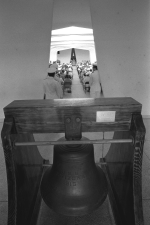 | 485k | A view of one of the two bells used on the Arizona (BB-39). The bell has been placed at the entrance to the Arizona Memorial. In the background, a ceremony commemorating the 40th anniversary of the Japanese attack on Pearl Harbor is taking place, 7 December 1981.
| USN photo # DN-SN-82-04604, by JOCS John D. Burlage, from the Department of Defense Still Media Collection, courtesy of dodmedia.osd.mil. |
 | 6539k | A closeup of a model of the wrecked Arizona (BB-39), 28 February 1988. The model, designed by Robert Sumerall, is based on architectural drawings and measurements taken by Navy divers from Mobile Diving Salvage Unit One during Project Sea Mark, a four-year undersea survey and mapping study of naval historic sites. The study is being conducted in conjunction with the U.S. Park Services's Submerged Cultural Resource Unit.
| USN photo # DN-ST-88-03857, by Lt Cmdr. Tracy Connors, from the Department of Defense Still Media Collection, courtesy of dodmedia.osd.mil. |
 | 618k | A close-up view of architectural drawings used by members of Mobile Diving Salvage Unit One as they survey the wreck of the Arizona (BB-39), during Project Sea Mark, a four-year undersea survey and mapping study of naval historic sites. | USN photo # DN-ST-88-03858, by Lt Cmdr. Tracy Connors, from the Department of Defense Still Media Collection, courtesy of dodmedia.osd.mil. |
 | 593k | A 1/96th scale model of the wrecked Arizona (BB-39) which was sunk during the Japanese attack on Pearl Harbor on 7 December 1941. | USN photo # DN-ST-88-01462, by Lt Cmdr. Tracy Connors,from the Department of Defense Still Media Collection, courtesy of dodmedia.osd.mil. |
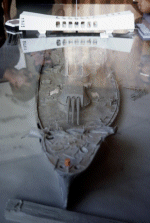 | 467k | A 1/96th scale model of the wrecked Arizona (BB-39) and the memorial which spans its hull. | USN photo # DN-ST-88-01463, by Lt Cmdr. Tracy Connors, from the Department of Defense Still Media Collection, courtesy of dodmedia.osd.mil. |
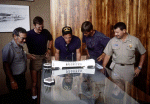 | 142k | Members of Mobile Diving Salvage Unit 1 and a Park Service member examine a 1/96th scale model of the wrecked Arizona (BB-39) and the memorial which spans its hull. | USN photo # DN-ST-88-01465, by Lt Cmdr. Tracy Connors, from the Department of Defense Still Media Collection, courtesy of dodmedia.osd.mil. |
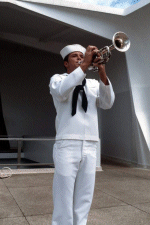 | 60k | A bugler plays taps as the remains of a crew member of the battleship Arizona (BB-39) are committed to the sunken vessel during a memorial service at the Arizona Memorial on 13 September 1990. The remains, stored in a canister, will be dropped into an opening in the battleship's submerged hull.
| USN photo # DN-ST-90-11917, by PH1 Mike D.P. Flynn, from the Department of Defense Still Media Collection, courtesy of dodmedia.osd.mil. |
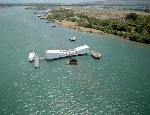 | 520k | An aerial view of the Arizona Memorial on 1 June 1991 at the northeast end of Ford Island, with markers in the background indicating battleships lost during the Japanese attack on Pearl Harbor on 7 December 1941.
| USN photo # DN-SC-93-04706, by PH3 BOS, from the Department of Defense Still Media Collection, courtesy of dodmedia.osd.mil. |
 | 541k | The U.S. Pacific Fleet Band performs for Arizona (BB-39) survivors and their families during Remembrance Day ceremonies at the Arizona Memorial Visitors Center, 4 December 1991. The event commemorates the 50th anniversary of the 7 December 1941, attack on Pearl Harbor, and the band is performing the music played by sailor musicians aboard several battleships during a "Battle of Music" competition in 1941. | USN photo # DN-SC-92-05776, by JOC(AW) Chet King, from the Department of Defense Still Media Collection, courtesy of dodmedia.osd.mil. |
 | 790k | Alfred Preis, designer of the Arizona Memorial, speaks during an observance of the 50th anniversary of the Japanese attack on Pearl Harbor, 6 December 1991.
| Photo # DN-SC-92-06648 by JOC(AW) Gloria Montgomery, & text from the Department of Defense Still Media Collection, courtesy of dodmedia.osd.mil. |
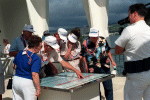 | 663k | Arizona (BB-39) survivors and their families view the schematic of the battleship at the Arizona Memorial following Remembrance Day ceremonies commemorating the 50th anniversary of the 7 December 1941, attack on Pearl Harbor. The schematic shows the configuration of the battleship before and after the bombing. | Photo # DN-SC-92-05786 by JOC(AW) Gloria Montgomery, & text from the Department of Defense Still Media Collection, courtesy of dodmedia.osd.mil. |
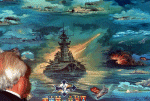 | 376k | A guest studies a painting depicting the history of battleships. The artwork was painted by George Skybeck and presented to the Pearl Harbor Survivors Association during their annual banquet at Honolulu, Hawaii, on 8 December 1991.
| USN photo # DN-SC-92-05391, by PHC Carolyn Harris, from the Department of Defense Still Media Collection, courtesy of dodmedia.osd.mil. |
 | 828k | Arizona (BB-39) II, scale model. | USN photo courtesy of Tommy Trampp. |
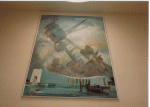 | 88k | Painting above as you enter the Arizona Memorial. | Photo contributed by Robert M. Cieri.
| 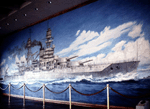 | 786k | Painting by John Charles Roach of the Arizona (BB-39) underway which appears in the Arizona Memorial. | Photo contributed by Chris Howell.
|  | 75k | An Acrylic on illustration board by the Official Navy Artist DM2 Robert Adam Malin, entitled Arizona Memorial was done as part of the RIMPAC 98 operation. Kitty Hawk (CVA-63) pulls in to relieve Independence (CVA-62) in Pearl Harbor. Missouri (BB-63) is in the background.
| U.S.S. Arizona Memorial,
Robert Adam Malin
Acrylic on illustration board, 1998,
98-110-D,
from the collections of the Naval Historical Center.
|
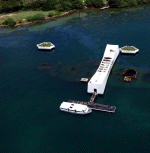 | 350k | Visitors prepare to enter the Arizona Memorial while the National ensign flies at half mast during a ceremony to commemorate the 61st Anniversary of the Japanese sneak attack on Pearl Harbor. The ceremony is held annually at the Arizona Memorial. | Courtesy of Bernard A. Cardali. |
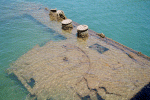 | 826k | View of the starboard side of the Arizona (BB-39) showing one of the 5/51 caliber foundation ring. The sunken ship rests at an 8 degree angle so this side of the ship is partially out of the water at low tide, 3 Jun 2000. | Defense Visual Information Center photo # DN-SC-02-05624, by PHC Don S. Montgomery, courtesy of dodmedia.osd.mil. |
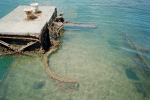 | 768k | View looking down on the portside of the Arizona (BB-39) showing the foundation of the case mate for the 5/51 caliber guns, 3 Jun 2000. | Defense Visual Information Center photo # DN-SC-02-05623, by PHC Don S. Montgomery, courtesy of dodmedia.osd.mil. |
 | 733k | View looking down on the port side of the Arizona (BB-39) showing bulwark, railing around the deck of a ship. In the center, the box like structures are the ovens in the galley section with cooking utensils and china scattered about in the silt. | Defense Visual Information Center photo # DN-SC-02-05622, by PHC Don S. Montgomery, courtesy of dodmedia.osd.mil. |
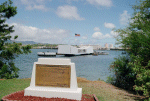 | 963k | A bronze plaque commemorates the loss of the Arizona (BB-39) at quarry Fox no. 7 on the morning of 7 December 1941 during the opening moments of the Japanese attack. In the background the Arizona Memorial spans the sunken hulk of the gallant ship where lie entombed more than 1100 of her fallen crew, 8 Jun 2000.
| Defense Visual Information Center photo # DN-SC-02-05677, by PHC Don S. Montgomery, courtesy of dodmedia.osd.mil. |
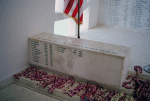 | 81k | A marker inside the shrine room of the Arizona (BB-39) listing the names of survivors of the sinking of the battleship that have since been interned aboard the sunken ship upon their passing. There were 268 survivors who may be interned on their fallen ship. This marker names those who have chosen to do so.
| Defense Visual Information Center photo # DN-SC-02-05626, by PHC Don S. Montgomery, courtesy of dodmedia.osd.mil. |
 | 97k | Pearl Harbor, the forward section on the Arizona (BB-39). You can see where the bow (marked by float), turret 2, and part of the superstructure is. Also the mooring quays where the Arizona, Tennessee (BB-43) and West Virginia (BB-48) were moored are off in the distance. Nowadays, those have been removed and a pier put in its place and the Missouri (BB-63) now occupies this spot. | Courtesy of Lacy Lee. |
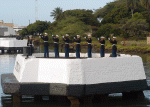 | 424k | Members of the U.S. Marine Corps Rifle Detail perform a 21-gun salute during the 62nd Pearl Harbor Anniversary ceremony of the attack on Pearl Harbor, held aboard the Arizona Memorial. More than 250 distinguished visitors and veterans were expected to attend the ceremony which also included the guided missile destroyer O'Kane (DDG-77) rendering honors, more than 40 wreath presentations, a 21-gun salute and the playing of taps. The Guest Speaker was Commander, U. S. Pacific Command, Adm. Thomas B. Fargo. | USN photo # N-5024R-087 by Photographer's Mate 2nd Class Johnnie R. Robbins, courtesy of news.navy.mil. |
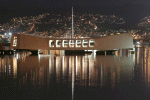 | 296k | The Arizona Memorial is bathed in light from a neighboring community the night before the 62nd Commemoration of the 7 December 1941 attack on Pearl Harbor. More than 250 distinguished visitors and veterans will attend the ceremony and will include the guided-missile destroyer O'Kane (DDG-77) rendering honors, followed by more than 40 wreath presentations, a 21-gun salute and the playing taps. The guest speaker will be Commander U. S. Pacific Command, Adm. Thomas B. Fargo. | USN photo # N-3228G-001 by Photographer's Mate 1st Class William R. Goodwin., courtesy of news.navy.mil. |
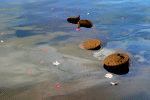 | 241k | Flowers drift past exposed parts of the sunken battleship Arizona during the 62nd Commemoration of the attack on Pearl Harbor aboard the Arizona Memorial. More than 250 distinguished visitors and veterans were expected to attend the ceremony which also included the guided missile destroyer O'Kane (DDG-77) rendering honors, more than 40 wreath presentations, a 21-gun salute and the playing of taps. Adm. Fargo was the guest speaker at the commemoration. | USN photo # N-3228G-021 by Photographer's Mate 1st Class William R. Goodwin., courtesy of news.navy.mil. |
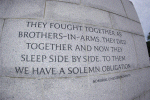 | 371k | A quote made by Fleet Adm. Chester W. Nimitz is inscribed on a granite wall at the National World War II Memorial located on the National Mall in Washington, D.C. Fleet Adm. Nimitz was the United States signatory to the surrender terms aboard the battleship Missouri (BB-63) in Tokyo Bay, Japan on 2 September 1945, thus ending World War II. Established by the American Battle Monuments Commission, the memorial honors all military veterans of World War II, the citizens on the home front, the nation at large, and the high moral purpose and idealism that motivated the nation's call to arms. On 29 May 2004, the memorial was formally dedicated with an estimated 200,000 people expected to attend, and includes 100,000 visiting veterans of all wars. | USN photo # N-0295M-011 by Photographer's Mate 2nd Class Daniel J. McLain, courtesy of news.navy.mil. |
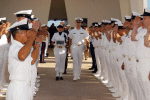 | 129k | Navy Region Hawaii Command Master Chief Luis R. Cruz and Force Master Chief Michael Banko, present flags to David and Tony Czarnecki, the sons of Chief Machinist's Mate Anthony Francis Czarnecki during a burial at sea ceremony 30 September 2004 aboard the Arizona Memorial. Czarnecki and his brother Stanley both served aboard the battleship Arizona (BB-39). Czarnecki and his brother were among 36 sets of brothers assigned to Arizona during the 7 December 1941 attack on Pearl Harbor. Czarnecki's brother was killed in the attack and Czarnecki's last wish was to be returned to Arizona to be with his brother and shipmates upon his passing. There were also 29 sets of twins and 4 sets of triplets were among the dead aboard the ship. | USN photo # N-4995T-103 by Photographer's Mate 3rd Class Victoria A. Tullock, courtesy of news.navy.mil. |
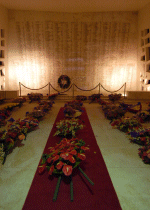 | 257k | Wreaths lay in the shrine room of the Arizona Memorial on the eve of the 63rd Commemoration of the 7 December 1941 attack on Pearl Harbor, 6 December 2004. More than 200 distinguished visitors and Pearl Harbor survivors will attend the ceremony. The keynote speaker for the event will be Deputy Commander, U.S. Pacific Command, Vice Adm. Gary Roughead. | USN photo # N-3019M-001 by Journalist 3rd Class Ryan C. McGinley, courtesy of news.navy.mil. |
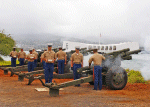 | 289k | With the Arizona Memorial in the background, U.S. Marines fire a nineteen-gun salute in honor of the arrival of Chief of Naval Operations, Adm. Vern Clark, during the Change of Command for Commander Pacific Fleet in Pearl Harbor, 6 July 2005.
Adm. Gary Roughead relieved Adm. Walter F. Doran as Commander of the U.S. Pacific Fleet, the Navy's largest area of responsibility in a ceremony pier side at the Battleship Missouri Memorialon Ford's Island. The Pacific Fleet is made up of approximately 200 ships and 1,400 aircraft, and more than 190,000 Sailors, Marines and civilians. | USN photo # N-9076B-038 by Chief Photographer's Mate Donald Bray, courtesy of news.navy.mil. |
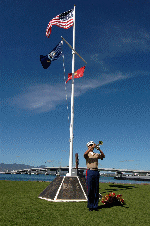 | 241k | U.S. Marine Corps Sgt. Louis Magana echoes taps on his bugle during a ceremony on 14 November 2005 dedicating a new flagstaff and display of bronze plaques commemorating 73 Marines who gave their lives and 15 survivors of the attack on the battleship Arizona (BB-39) at Pearl Harbor 7 December 1941. The memorial features the names of the 88 Marines stationed aboard Arizona during the attack, a piece of steam pipe from Arizona's original hull, the National Ensign, the U.S. Navy and U.S. Marine Corps flag. | USN photo # N-3019M-004 by Journalist 3rd Class Ryan C. McGinley, courtesy of news.navy.mil. |
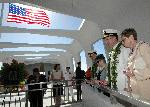 | 273k | Chief of Naval Operations Adm. Mike Mullen prepares to toss a flower into the well aboard the Arizona Memorial after the 64th commemoration of the 7 December 1941 attack on Pearl Harbor, Hawaii, 7 December 2005. The ceremony, which included remarks by keynote speaker Mullen, is held annually to honor those who served during the Japanese surprise attack on Pearl Harbor. | USN photo # N-3019M-019, by Journalist 2nd Class Ryan C. McGinley, courtesy of news.navy.mil. |
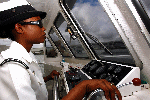 | 287k | Boatswain's Mate 2nd Class Yochebed Israel pilots a tour boat from the Arizona Memorial Detachment during a tour of Pearl Harbor and the Arizona relics by a group of Sailors from the Pearl Harbor Surface Navy Association (SNA) on 16 March 2006. | USN photo # N-9643K-003, by Chief Journalist Joe Kane, courtesy of news.navy.mil. |
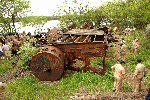 | 696k | Sailors from the Pearl Harbor Surface Navy Association (SNA) visit the site of the Arizona relics. The Arizona relics are parts of Arizona (BB-39) that were removed from the water and placed on shore near Pearl Harbor's West Loch. | USN photo # N-9643K-007, by Chief Journalist Joe Kane, courtesy of news.navy.mil. |
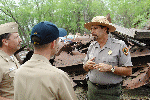 | 310k | National Park Service Ranger Daniel Martinez addresses a group of Sailors from the Pearl Harbor Surface Navy Association (SNA) at the site of the Arizona relics. | USN photo # N-9643K-010, by Chief Journalist Joe Kane, courtesy of news.navy.mil. |
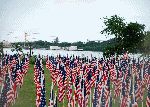 | 366k | The Arizona Memorial can be seen in the distance from the Healing Field Flag Memorial at Pearl Harbor for the 66th anniversary of the attack on Pearl Harbor 7 December 2007. The Healing Field at Pearl Harbor featured 2,804 flags, each standing eight-feet tall, to commemorate each service member killed 7 December 1941. | USN photo # N-3283M-035 by Mass Communication Specialist 2nd Class Sarah Murphy, courtesy of news.navy.mil. |
 | 330k | National Park Service divers hold the remains of U.S. Navy Seaman 1st Class Charles Guerin Jr. during an interment ceremony at the Arizona Memorial in Pearl Harbor, Hawaii, 7 December 2008. Guerin was a former Sailor stationed aboard Arizona (BB-39) during the 7 December 1941, attack on Pearl Harbor. | DoD photo # N-0535P-253 by Mass Communication Specialist 2nd Class Jay C. Pugh, U.S. Navy. |
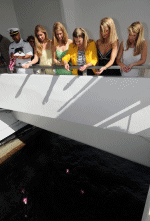 | 200k | On December 23 the granddaughter of a Pearl Harbor Sailor, her husband and their four daughters came to Oahu to visit Arizona (BB-39) where her grandfather is entombed.
Mary Kidd-Plumer is the granddaughter of Rear Adm. Isaac C. Kidd, who was aboard the ill-fated Arizona as the commander Battleship Division 1 and chief of staff to Commander, Battleships, Battle Force.
Sixty-seven years ago, the early Sunday morning calm was broken with the roar of Japanese planes, machine gun fire and explosions from torpedoes that ripped through the hulls of the still gray ships nestled in the harbor.
On 7 December 1941, Kidd was killed in action on board Arizona during the Pearl Harbor raid. He was posthumously awarded the Medal of Honor for his actions during the attack. He is one of the 1,177 Sailors and Marines who died on board Arizona.
Today, a memorial stands in honor of Kidd and the 1,176 other men. Their names and ranks are inscribed on the memorial, where Plummer and her family, along with millions of others, have come to pay their respects.
According to Plummer, who last visited the memorial at the age of 2, she was delighted to have returned and share the experience with her family.
"The last time I was here I was two-years old," said Plummer, now 50 and the youngest of six. "My mother's got a picture somewhere of the visit with dad holding me, and all of us standing around on a plank looking at the Arizona. That was long before the Arizona Memorial was built."
Along with her husband Gary, their daughters, Corrinne age 21, Angelique, age 19, Natalie, age 18, and the youngest, Michelle, age 16, visited the Arizona Memorial Visitor Center prior taking the Navy boat to the memorial.
There -- along with numerous artifacts, paintings and inscriptions -- stands a larger-than-life display of her grandfather.
Michelle felt honored to know she is a living legacy of a true American hero as she read the inscriptions and gazed at the artifacts. Some say, they notice similarities between Kidd and his visiting great granddaughters.
As Michele stood in front of the display, it was as though Kidd, whose portrait once adorned the very walls of the Kidd household, now looks out to the visitors, and now family, visiting him.
"It's really amazing. I didn't know this was here – the display with things found on the Arizona," said Michelle. "I am very proud of my grandfather and great grandfather for what they did for the Navy and how they supported our country."
The eldest daughter, Corrinne, was also impressed by what she saw and is proud of her family's heritage, but at the same time felt it strange to see the display.
"It is very surreal seeing all of this because we see our grandfather and great grandfather as just family," said Corrinne. "It's so amazing to realize that so many people feel our level of compassion. It's a great feeling."
Corrinne is poised to keep the family tradition of naval service alive. She is now considering a commission through officer candidate school (OCS) and becoming a surface warfare officer (SWO), like her grandfather and great grandfather.
"If I go to OCS, it would probably be to be a SWO. It runs in the family. We definitely have the family bloodline; it's our calling and passion. I learned to walk at the Naval Academy. It's where I took my first steps, and that's where our grandfather's buried," Corrinne said.
At the memorial, Plummer and her family said prayers to her grandfather, as well as for the Sailors and Marines who lay with him. They quietly dropped flower petals from a lei given to Plummer as a token of appreciation to her family.
Plummer was humbled by the experience.
"It makes us all so proud," said Plummer. "It is because of men like them that we are all here today and it is a true honor to be here and we are so proud of all of them."
| USN photo # N-0879R-011 by Chief Mass Communication Specialist David Rush, courtesy of news.navy.mil. |
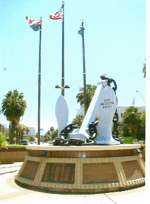 | 400k | The Arizona's (BB-39) Anchor in Wesley Bolin Memorial Park located in front of the Arizona State Capitol in Phoenix, Az. | Courtesy of Tommy Trampp. |
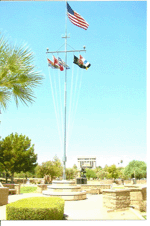 | 109k | Arizona's (BB-39) Mast in Wesley Bolin Memorial Park located in front of the Arizona State Capitol in Phoenix, Az. | Courtesy of Tommy Trampp. |
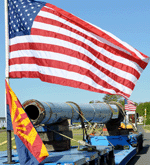 | 426k | 6 photo PDF of a 14-inch gun barrel from the battleship Arizona (BB-39) as begins its move from the Naval Surface Warfare Center Dahlgren Division in Virginia to Phoenix, Ariz. on 10 April 2012. The gun barrel, removed from Arizona to be relined before World War II, was at the Dahlgren Naval Proving Ground for proof testing when the attack on Pearl Harbor occurred 7 December 1941. The state of Arizona is also moving a Missouri (BB-63) gun barrel from Norfolk Naval Shipyard's St. Julien's Creek Annex to exhibit with the Arizona gun. These two barrels represent "bookends" of World War II, the beginning and end of the war. | USN photo # N-DI674-005 by John J. Joyce courtesy of news.navy.mil. via Ron Revees (of blessed memory). |
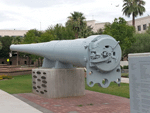
013997 | 548k | 14-inch gun formerly on Arizona (BB-39), displayed at Wesley Bolin Memorial Plaza near the Arizona State House, Phoenix, Arizona. | Photo courtesy of Rob Duch via Yu Chu.
|  | 579k | Builder 2nd Class Keith Reed, from Construction Dive Detachment Alpha, part of Underwater Construction Team (UCT) 2 out of Port Hueneme, Calif., dives over the remains of the Arizona (BB-39) on Joint Base Pearl Harbor-Hickam on 21 March 2013. UCT-2 provides a capability for construction, inspection, repair, and maintenance of ocean facilities in support of Naval and Marine Corps operations. | USN photo # N-WX059-273 by Mass Communication Specialist 2nd Class Sean Furey, courtesy of navy.news.mil. |
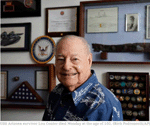
013935a |
416k |
Lou Conter, the last survivor of Arizona (BB-39) died Monday 1 April at the age of 102.
The sole survivor serving aboard the Arizona during the Japanese attack on Pearl Harbor has died.
Lou Conter, one of the last living ties to that date of infamy, passed away this morning at his home in Grass, Valley, California, Pacific Historic Parks confirmed. He was 102.
Born in Ojibwa, Wisconsin, Conter enlisted in the U.S. Navy in 1939 at the age of 18. Two years later, he would bear witness to the attack that finally drew the United States into the Second World War.
Starting his shift as quartermaster at 7:45 a.m. on 7 Dcember 1941, Conter had barely rubbed the sleep from his eyes when the Japanese assault began a mere three minutes later.
At exactly 8:09 a.m., the hull of the Arizona was struck by a 1,760-pound Japanese armor-piercing bomb.
Japanese horizontal bombers swirling overhead continued to cause damage, striking the Arizona's midship areas. The massive explosion that soon followed has never been explained, according to the Naval History and Heritage Command, since the bomb did not pierce Arizona's armored deck. It is believed, however, that the bomb that penetrated her forward turrets struck nearly one million pounds of gunpowder, causing the turrets, conning tower and much of the superstructure to be obliterated.
The ship continued to burn for more than 48 hours after the attack.
"Minute it happened, we sounded general quarters and they were in there and we blew up in about eight minutes, nine minutes," Conter told CBS13 in 2022.
Knocked over from the blast, Conter landed on the deck which was rapidly filling with water.
Despite the conflagration spreading throughout the badly listing ship, Conter remained composed, spending nearly 35 minutes attempting to secure the quarterdeck and saving nearly 20 sailors.
Of the 2,403 American sailors, soldiers and civilians killed that day, 1,177 came from Arizona's crew. Conter was just one of 335 aboard the battleship to survive.
But his duty to Arizona's crew did not cease on 7 December. Conter joined numerous rescue operations to recover the bodies of his shipmates in the chaotic days that followed the attack.
However, after five days of "diligently searching, it was apparent that no one remained alive, and the risk of the operation became too high to continue," according to a Veterans Affairs release
"Although most of the fuel aboard the ship fed the explosion, 500,000 gallons slowly seeped from the wreckage," the release said. "Nearly 80 years after the attack, the Arizona continues to spill up to 9 quarts of oil per day into the harbor. This is often referred to as the ‘tears of the Arizona.
Nearly 900 sailors still lie entombed in the Arizona.
Following the attack on Pearl Harbor, Conter entered flight school, serving as a pilot with the Navy Squadron dubbed the Black Cats due to black paint adorning the night-flying PBY Catalinas, according to VA News.
Conter survived the war, despite being shot down twice over the Pacific, and went on to serve in Korea as an air intelligence officer. Upon returning home, he worked to establish the Navy’s first SERE — Survival, Evasion, Resistance, and Escape — program and served as a military adviser to Presidents Dwight D. Eisenhower, John F. Kennedy and Lyndon B. Johnson.
Conter retired from the Navy as a lieutenant commander after 28 years of military service.
Today, fewer than two dozen survivors of the attack on Pearl Harbor attack remain alive.
"Our prayers go out to his close-knit family and friends that made up what became known as the‘Conterage,’" Aileen Utterdyke, president and CEO of Pacific Historic Parks, wrote in a Facebook post.
"This is a heartbreaking loss. Lou Conter epitomized what it meant to be a member of the Greatest Generation, Americans whose collective courage, accomplishments and sacrifices saved our country from tyranny. He had an exemplary career in the Navy and was steadfast in imploring the schools, parents and everyday Americans to always remember Pearl Harbor."
| Photo & text courtesy of Claire Barrett via militarytimes.com
Photo courtesy of Bob Haner. |
| | | |
